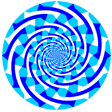 Tilt illusions and anomalous motion illusions
Tilt illusions and anomalous motion illusionsin RIKEN BSI
July 2, 2010
Thanks to Usui sensei
 Tilt illusions and anomalous motion illusions
Tilt illusions and anomalous motion illusions
Akiyoshi Kitaoka (Ritsumeikan University, Deptment of Psychology) email HP
since June 20, 2010 Abstract
Tilt illusion is a subcategory of geometrical illusion, in which lines or edges appear to tilt clockwise or counterclockwise. (e.g., Zöllner illusion, Fraser illusion, Café Wall illusion)
Anomalous motion illusion refers to motion illusion in a stationary image, in which part of the
stationary image appears to move. (e.g., Ouchi illusion, Enigma illusion,
optimized Fraser-Wilcox illusion)
Some* types of tilt illusions are accompanied by anomalous motion illusion. (e.g., Illusion of Y-junctions)
*Later, I have realized that most of tilt illusions (including the Fraser illusion and the Café Wall illusion) share the same image with anomalous motion illusion.
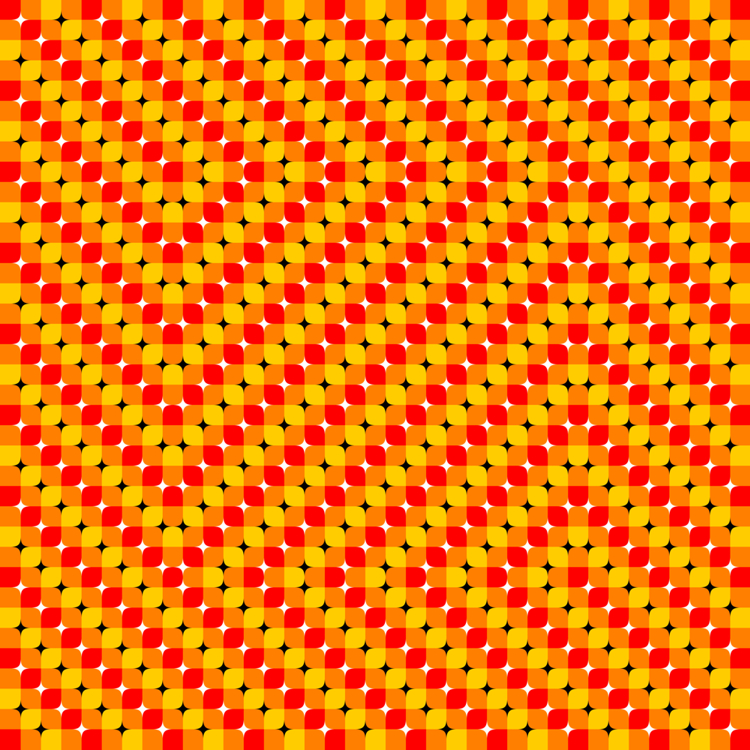
"The autumn color swamp"
The inset appears to move.
Copyright A.Kitaoka 2000, 2003, 2007, 2010
<Handout>
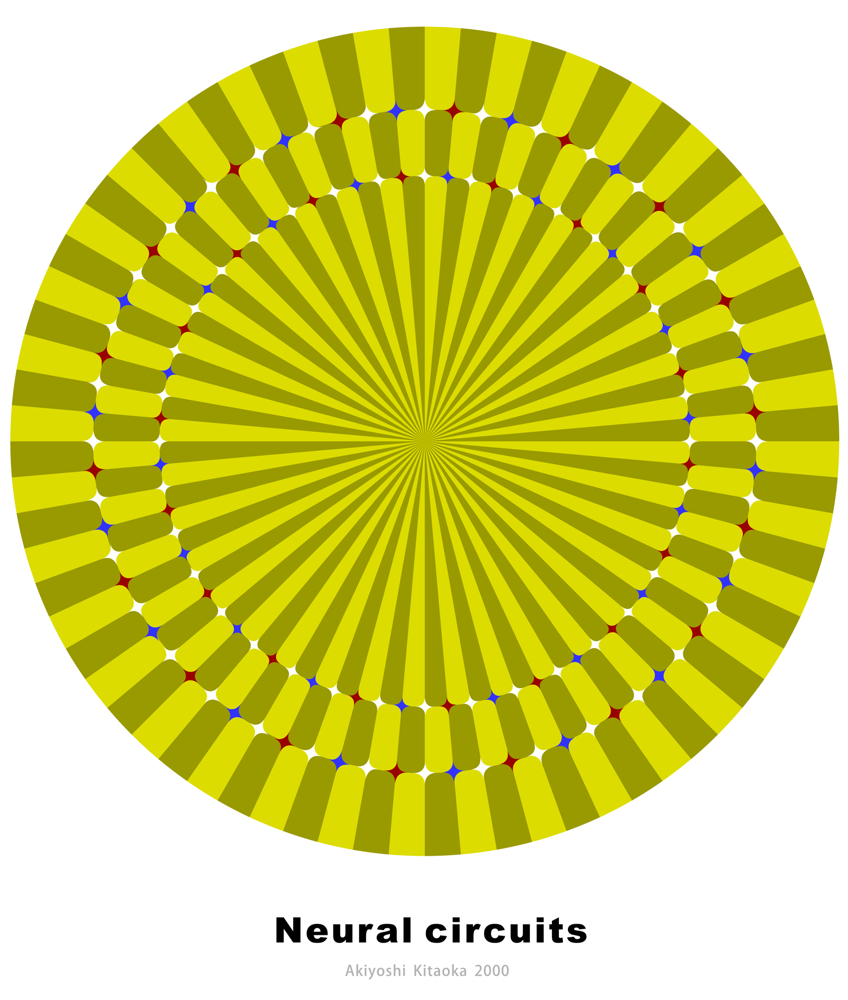
The two concentric arrays of stars appear to rotate in the different directions when we approach or move away from the figure while fixating at the center.
Copyright Akiyoshi Kitaoka 2000, 2010
<Handout>
Illusion of Y-junctions

The elemental image as the tilt illusion
The horizontal edge on which black or white stars are placed appears to tilt counterclockwise.
Kitaoka, A., Pinna, B., and Brelstaff, G. (2001). New variations of spiral
illusions. Perception, 30, 637-646.
Kitaoka, A., Pinna, B., and Brelstaff, G. (2004). Contrast polarities determine the direction of Cafe Wall tilts. Perception, 33, 11-20.
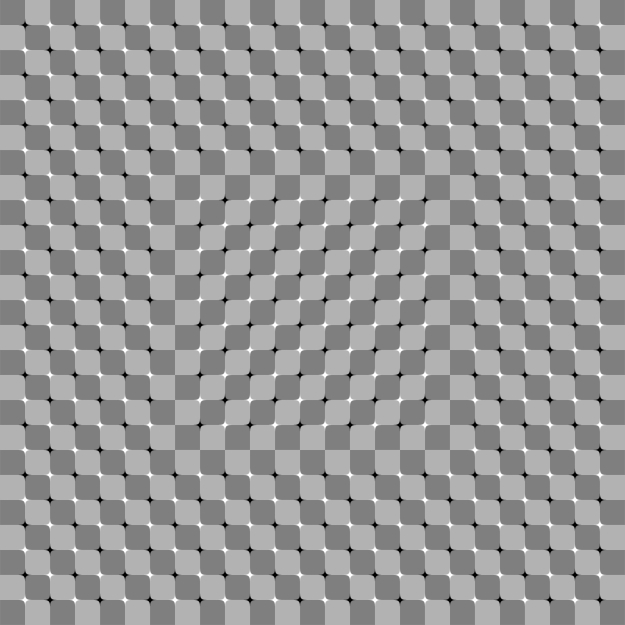
The elemental image as anomalous motion illusion
The inset appears to move. When the retinal image is moved vertically, the inset appears to move horizontally. When the retinal image is moved horizontally, the inset appears to move vertically.
<Handout>
Today's talk
1. "Discovery" of the Fraser illusion family
2. Anomalous motion illusion accompanied by tilt illusion
3. A speculation of the "Rotating snakes" illusion
§1. "Discovery" of the Fraser illusion family
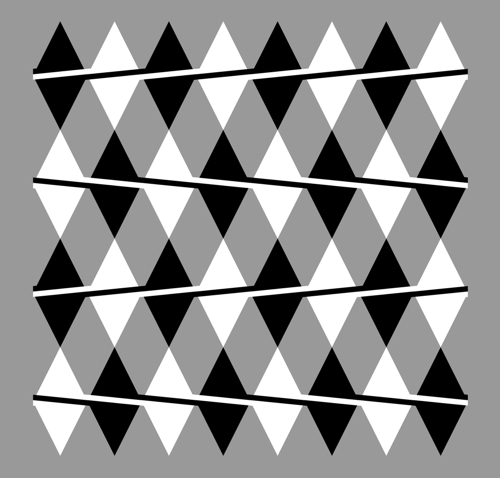
Fraser illusion
"Twisted cords" are horizontally aligned but appear to tilt alternately. The apparent tilt is the same orientation as the tilt of each obliques.
Drawn by Akiyoshi Kitaoka 2010 (March 20)
Fraser, J. (1908) A new visual illusion of direction. British Journal of Psychology, 2, 307-320.
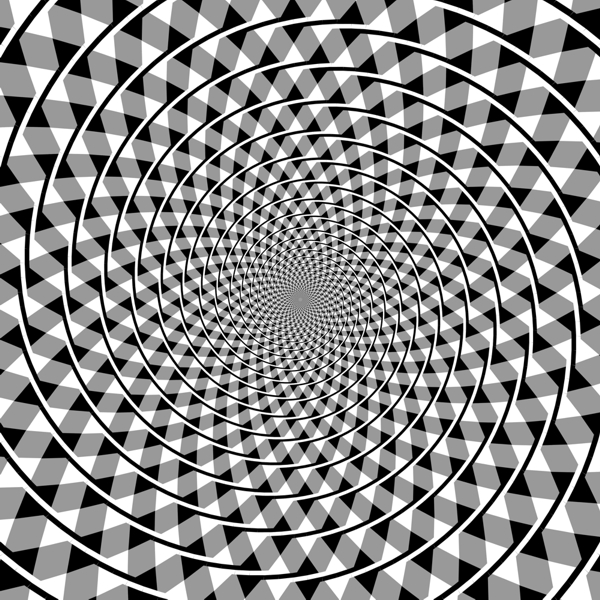
Fraser's spiral
(spiral illusion of the Fraser illusion)
Concentric circles of "twisted cords" appear to be spirals.
Drawn by Akiyoshi Kitaoka 2010 (March 20)
Fraser, J. (1908) A new visual illusion of direction. British Journal of Psychology, 2, 307-320.
<Handout>
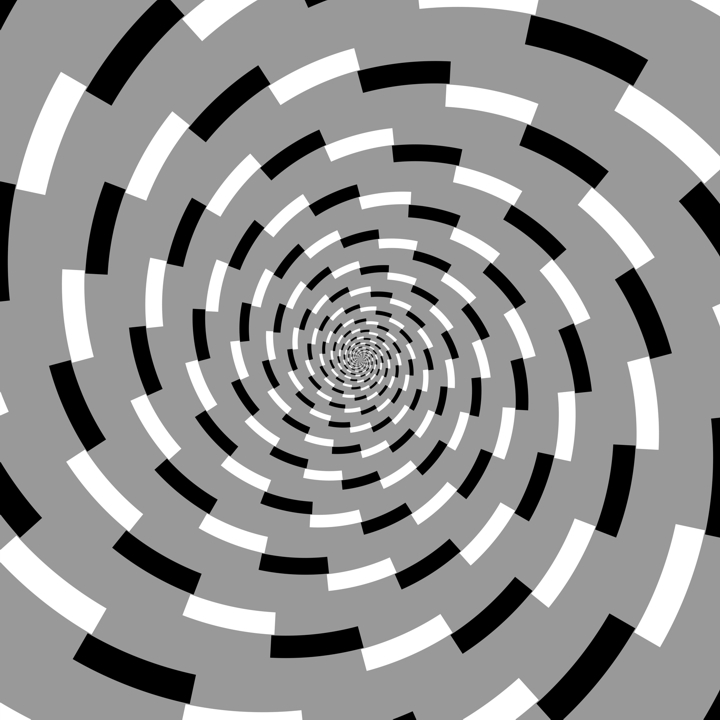
In December 2009, I developed a "new" illusion (though it essentially was not new), which I called the "pseudo Fraser illusion".
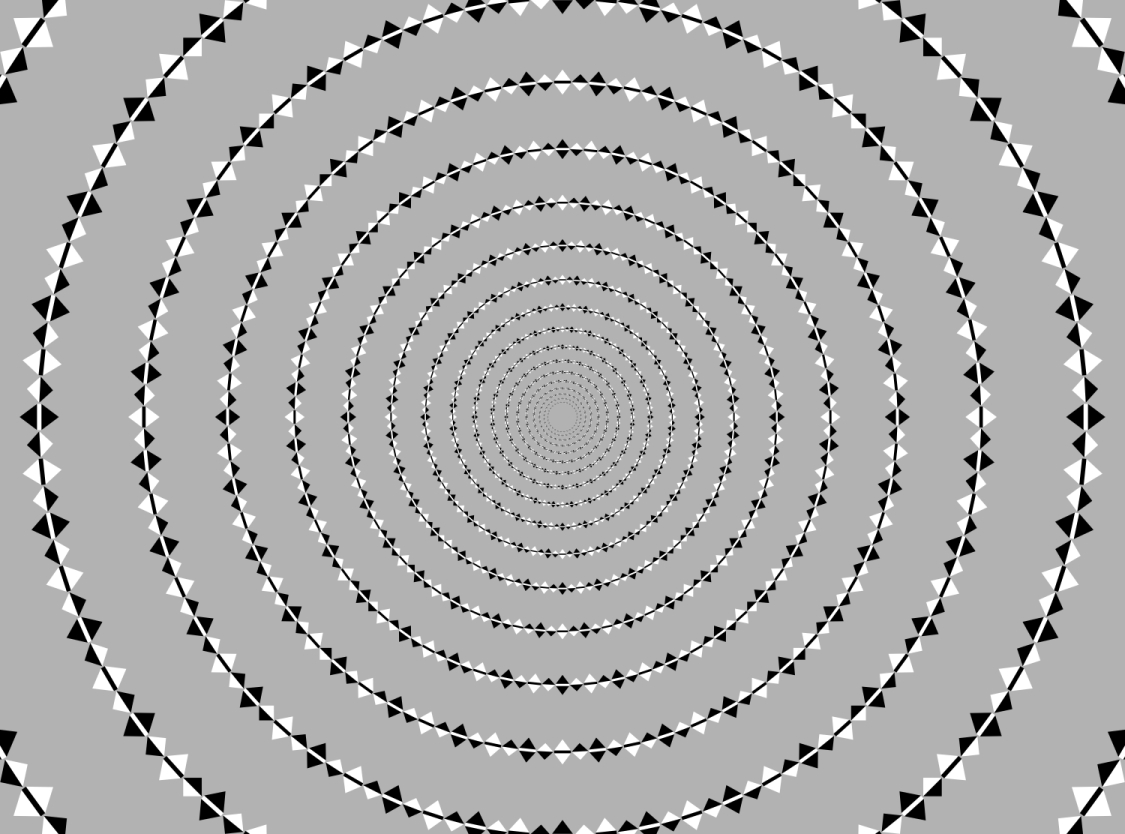
"Pseudo Fraser
spirals"
Concentric rings appear to be spirals.
Copyright Akiyoshi Kitaoka 2009 (December 17)
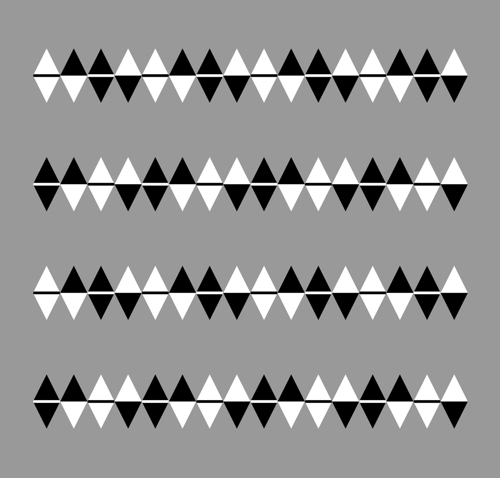
Psudo-Fraser illusion
("Fraser's Café Wall" illusion)
The middle lines are horizontally aligned but appear to tilt alternately. The apparent tilt is counterclockwise, clockwise, and so on from the top row.
Drawn by Akiyoshi Kitaoka 2010 (March 20)
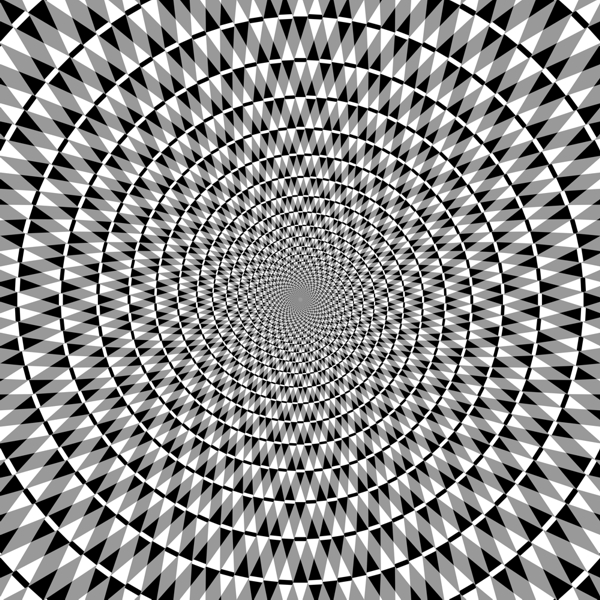
Pseudo-Fraser's spiral
(spiral illusion of the "Fraser Café Wall" illusion)
Concentric circles of "twisted cords" appear to be spirals.
Drawn by Akiyoshi Kitaoka 2010 (March 20)
Q. What are the differences between the Fraser illusion and the pseudo-Fraser illusion?
A. There are three factors involved:
1. whether the inducers are obliques (Fraser illusion) or not (pseudo-Fraser illusion)
2. whether the inducers are only lines (Fraser illusion) or combination of lines and edges (pseudo-Fraser illusion)
3. whether the inducers are two (Fraser illusion) or four (pseudo-Fraser illusion)
1. whether the inducers are obliques (Fraser illusion) or not (pseudo-Fraser illusion)
Finding: There are counterparts of the Fraser illusion as well as the pseudo-Fraser illusion, respectively

Fraser illusion
"Twisted cords" are horizontally aligned but appear to tilt alternately. The apparent tilt is the same orientation as the tilt of each obliques.
Drawn by Akiyoshi Kitaoka 2010 (March 20)
Fraser, J. (1908) A new visual illusion of direction. British Journal of Psychology, 2, 307-320.
The counterpart of the Fraser illusion
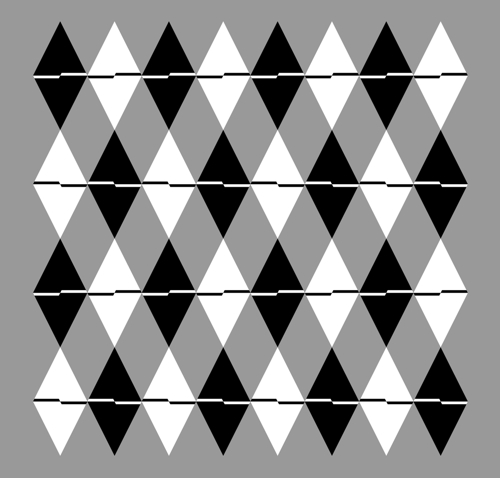
Illusion of shifted lines
Rows of middle line segments are horizontally aligned but appear to tilt alternately. The apparent tilt is counterclockwise, clockwise, and so on from the top row.
Drawn by Akiyoshi Kitaoka 2010 (March 20)
Kitaoka, A. (2007) Tilt illusions after Oyama (1960): A review. Japanese Psychological Research, 49, 7-19.

Psudo-Fraser illusion
("Fraser's Café Wall" illusion)
The middle lines are horizontally aligned but appear to tilt alternately. The apparent tilt is counterclockwise, clockwise, and so on from the top row.
Drawn by Akiyoshi Kitaoka 2010 (March 20)
The counterpart of the pseudo-Fraser illusion

The patterns like "twisted cords" are horizontally aligned but appear to tilt alternately. The apparent tilt is the same orientation as the tilt of each obliques.
Drawn by Akiyoshi Kitaoka 2010 (March 20)
2. whether the inducers are only lines (Fraser illusion) or combination of lines and edges (pseudo-Fraser illusion)
Finding: There are three groups in this sense, only lines, combinations of lines and edges, and only edges, respectively
Lines only

Fraser illusion
"Twisted cords" are horizontally aligned but appear to tilt alternately. The apparent tilt is the same orientation as the tilt of each obliques.
Drawn by Akiyoshi Kitaoka 2010 (March 20)
Fraser, J. (1908) A new visual illusion of direction. British Journal of Psychology, 2, 307-320.
Combination of lines and edges
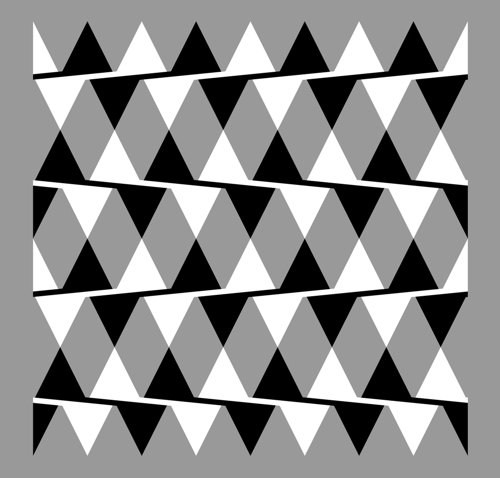
"Cafe Wall Fraser" illusion
The patterns like "twisted cords" are horizontally aligned but appear to tilt alternately. The apparent tilt is the same orientation as the tilt of each obliques.
Drawn by Akiyoshi Kitaoka 2010 (March 20)
Fraser, J. (1908) A new visual illusion of direction. British Journal of Psychology, 2, 307-320.
Edges only

Illusion of oblique edges
Rows of oblique edges are horizontally aligned but appear to tilt alternately. The apparent tilt is the same orientation as the tilt of each obliques.
Drawn by Akiyoshi Kitaoka 2010 (March 20)
Kitaoka, A. (2007) Tilt illusions after Oyama (1960): A review. Japanese Psychological Research, 49, 7-19.
3. whether the inducers are two (Fraser illusion) or four (pseudo-Fraser illusion)
Finding: The basic components of the Fraser illusion can be counted four to match the pseudo-Fraser illusion. In the same way, The basic components of the pseudo-Fraser illusion can be counted two to match the Fraser illusion. Thus, this factor is not essential for tilt illusion.

Fraser illusion
"Twisted cords" are horizontally aligned but appear to tilt alternately. The apparent tilt is the same orientation as the tilt of each obliques.
Drawn by Akiyoshi Kitaoka 2010 (March 20)
Fraser, J. (1908) A new visual illusion of direction. British Journal of Psychology, 2, 307-320.
The counterpart of the Fraser illusion
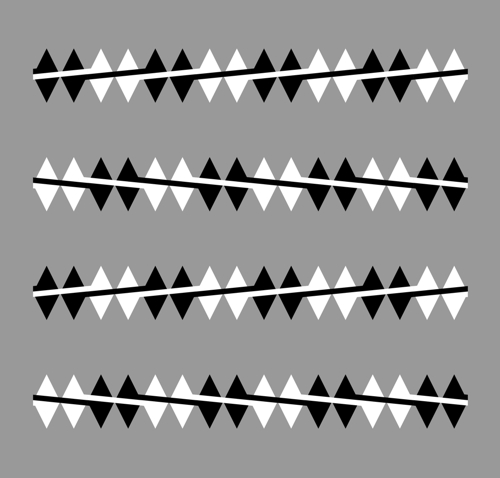
Fraser illusion
"Twisted cords" are horizontally aligned but appear to tilt alternately. The apparent tilt is the same orientation as the tilt of each obliques.
Drawn by Akiyoshi Kitaoka 2010 (March 20)
Fraser, J. (1908) A new visual illusion of direction. British Journal of Psychology, 2, 307-320.

Psudo-Fraser illusion
("Fraser's Café Wall" illusion)
The middle lines are horizontally aligned but appear to tilt alternately. The apparent tilt is counterclockwise, clockwise, and so on from the top row.
Drawn by Akiyoshi Kitaoka 2010 (March 20)
The counterpart of the pseudo-Fraser illusion
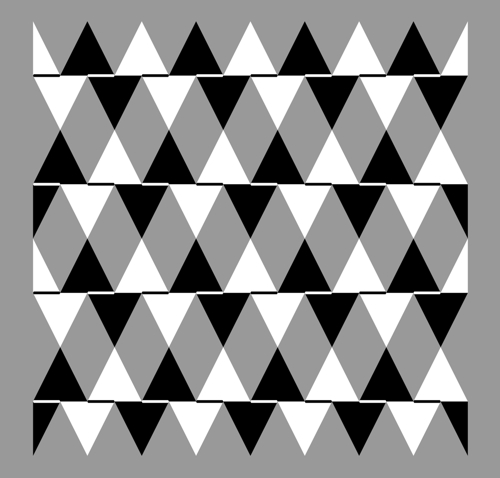
Psudo-Fraser illusion
("Fraser's Café Wall" illusion)
The middle lines are horizontally aligned but appear to tilt alternately. The apparent tilt is counterclockwise, clockwise, and so on from the top row.
Drawn by Akiyoshi Kitaoka 2010 (March 20)
cf. Fraser, J. (1908) A new visual illusion of direction. British Journal of Psychology, 2, 307-320.
Conclusion: The Fraser illusion family consists of six (3 x 2) illusions.
<Handout>
Q. How is the pseudo-Fraser illusion related to the Café Wall illusion?
A. I think they are essentally the same illusion.
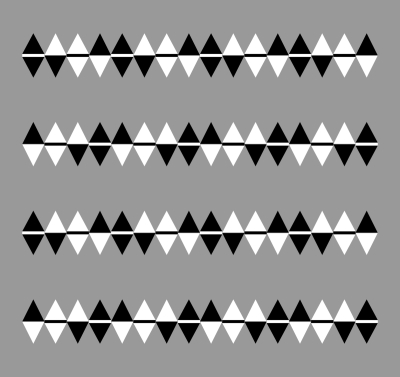
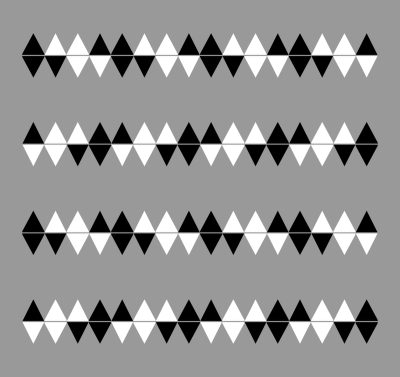
The pseudo-Fraser illusion (left) and the Café Wall illusion (right)
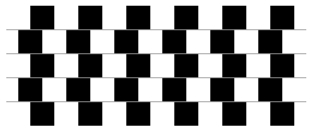
Café Wall illusion: a standard image
cf. Gregory, R. L. and Heard, P. (1979) Border locking and the Café Wall illusion. Perception, 8, 365-380.
Q. Does tilt illusion occur where contast polarity changes?
A. Yes, as if it were the reversed phi (the direction opposite to the shift).
(Illusion of oblique edges)
(Illusion of shifted lines)
Example
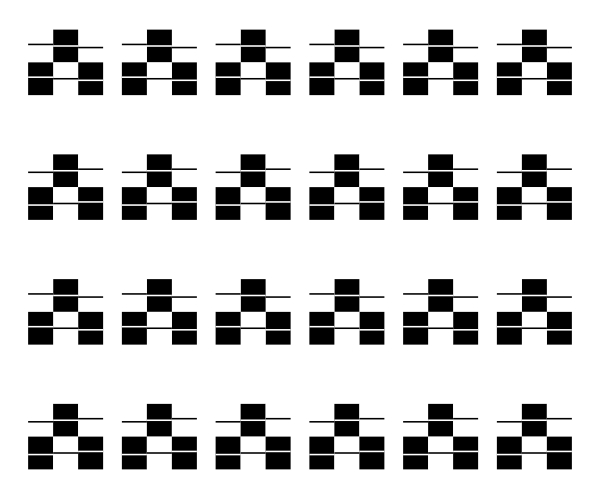
"Derby man tilt illusion"
Horizontally aligned rows of "derby men" appear to tilt alternately. From the top, counterclockwise, clockwise, and so on.
Copyright Akiyoshi Kitaoka 2010 (March 21)
My idea: There are eight fundamental combinations of basic components.
(I imagine that neurons with receptive fields like these play a part)
(The limiting case of the Fraser illusion family)
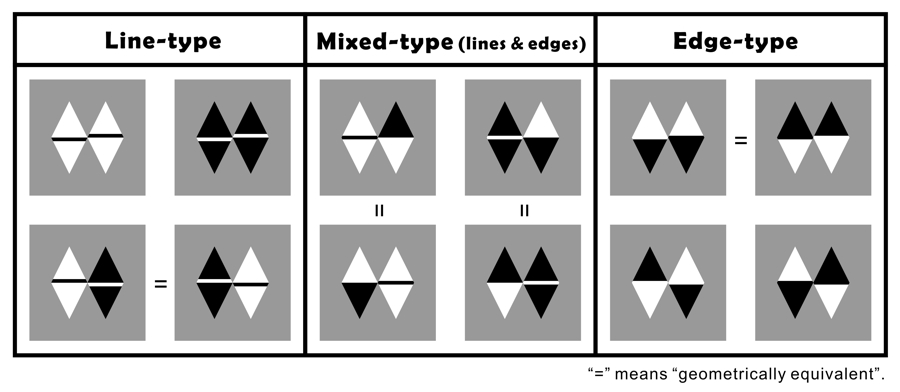
In each gray square, the middle line or edge appears to tilt counterclockwise.
Copyright Akiyoshi Kitaoka 2010 (March 22)
In addition: Café Wall illusion can be explained with this idea.

Café Wall illusion: a standard image
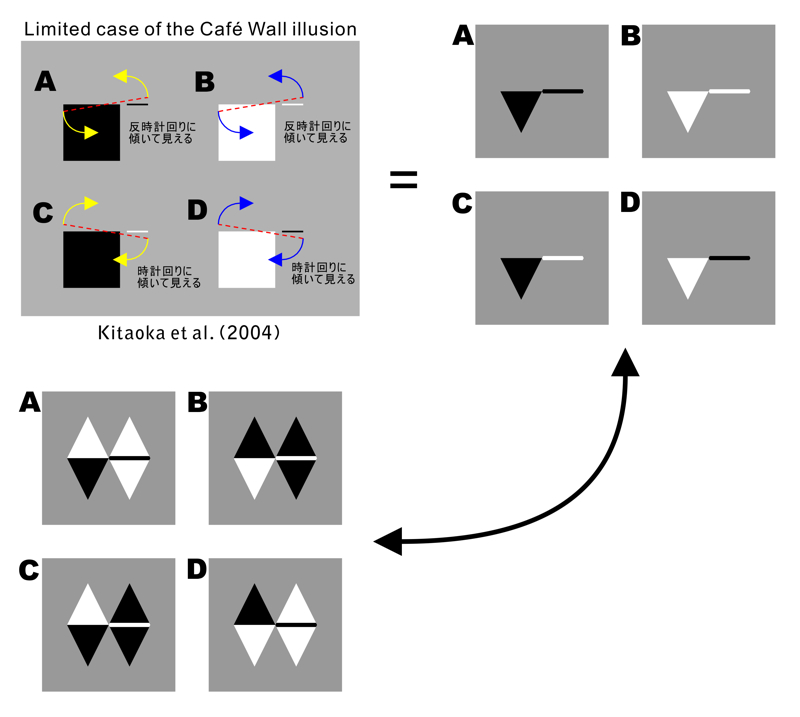
Copyright Akiyoshi Kitaoka 2010 (March 22)
Kitaoka, A., Pinna, B., and Brelstaff, G. (2004) Contrast polarities determine the direction of Café Wall tilts. Perception, 33, 11-20.
§2. Anomalous motion illusion accompanied by tilt illusion

"Obake-hime"
obake = ghost; hime = princess or girl
The face appears to expand; the group of bats appears to rotate counterclockwise. This is Professor Mather's four-stroke motion.
Copyright Akiyoshi Kitaoka 2009 (August 10)
Professor Mather's demonstration is the best.
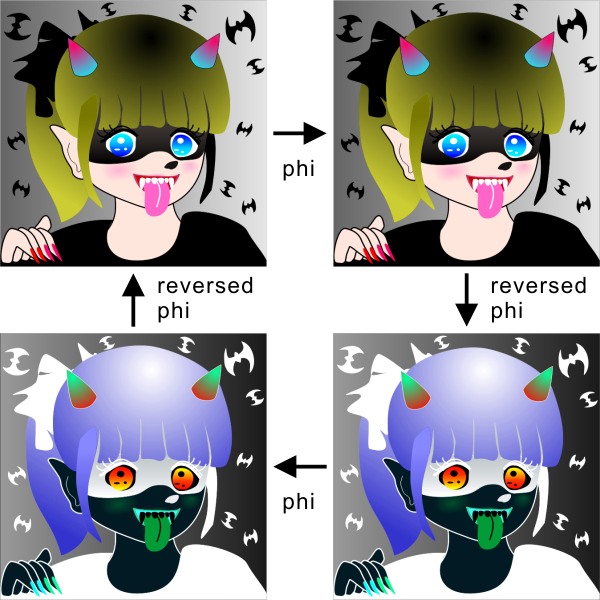
Copyright Akiyoshi Kitaoka 2010 (March 22)
(Reversed phi only)

Copyright Akiyoshi Kitaoka 2010 (March 22)
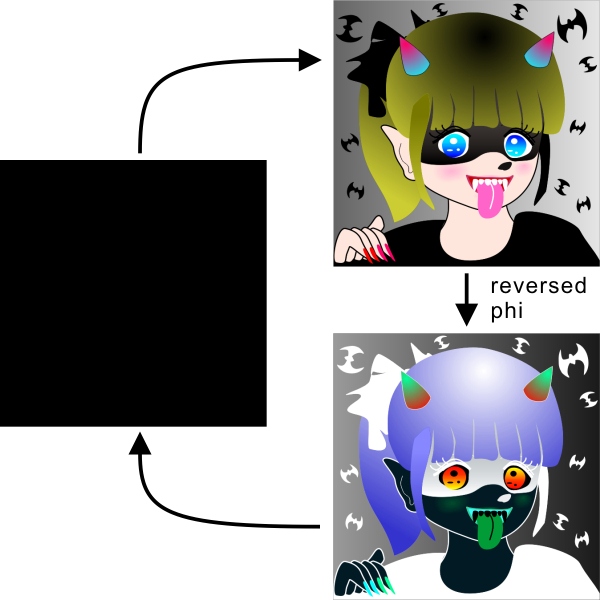
Reversed phi movement (Anstis and Rogers 1975). There are four rectangles, each of which is flanked by thin lines that are dark or light. When the luminance of the rectangles decreases and that of the background increases accordingly, the upper two appear to converge in motion while the lower two appear to go apart in motion. On the other hand, when the luminance of the rectangles increases and that of the background decreases accordingly, the upper two appear to go apart in motion while the lower two appear to approach each other in motion. In sum, the direction of apparent motion is from the dark flank to the neighboring part that goes darkening or from the light flank to the neighboring part that goes brightening. Although the rectangles are aligned vertically, the apparent positional displacement occurs in the opposite direction to motion. If observers cross-fuse (uncross-fuse) the right and left rectangles, the upper rectangle appears to be in front of (behind) the lower one when they are dark.
Kitaoka, A. (2006) Configurational coincidence
among six phenomena: A comment on van Lier and Csathó (2006). Perception,
35, 799-806. animations ![]()
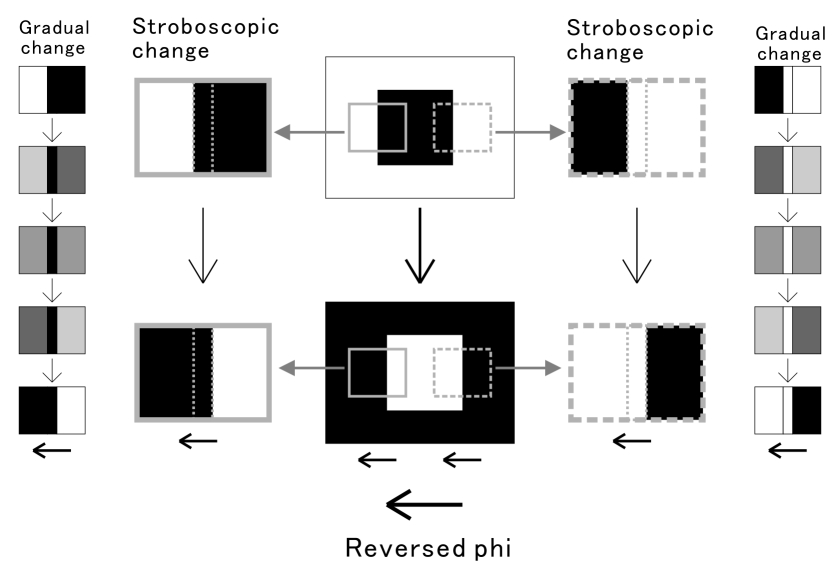
Anstis S M, 1970 “Phi movement as a subtraction process” Vision Research 10 1411-1430
Anstis S M, Rogers B J, 1975 “Illusory reversal of visual depth and movement during changes of contrast” Vision Research 15 957-961
4-stroke motion corresponding to the Line Type
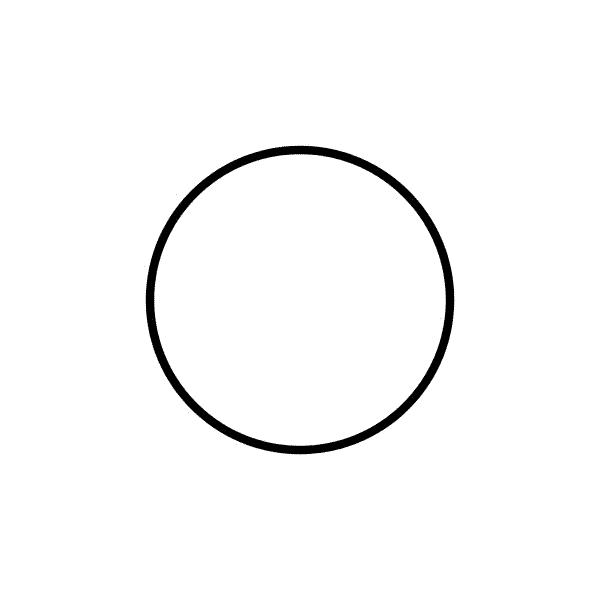
Copyright Akiyoshi Kitaoka 2010 (March 22)
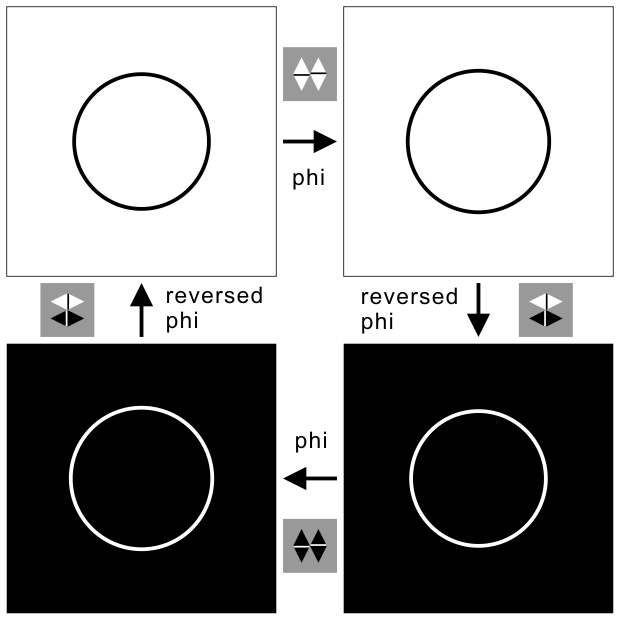
Finding: The direction of motion is the same as the tilt illusion.
Mather, G. and Murdoch, L. (1999) Second-order processing of four-stroke apparent motion. Vision Research, 39, 1795-1802.
cf. van Lier R, Csathó Á, 2005 “Dancing shapes: A comparison of luminance induced distortions” Perception, 35, 775 – 798.
4-stroke motion corresponding to the Edge Type
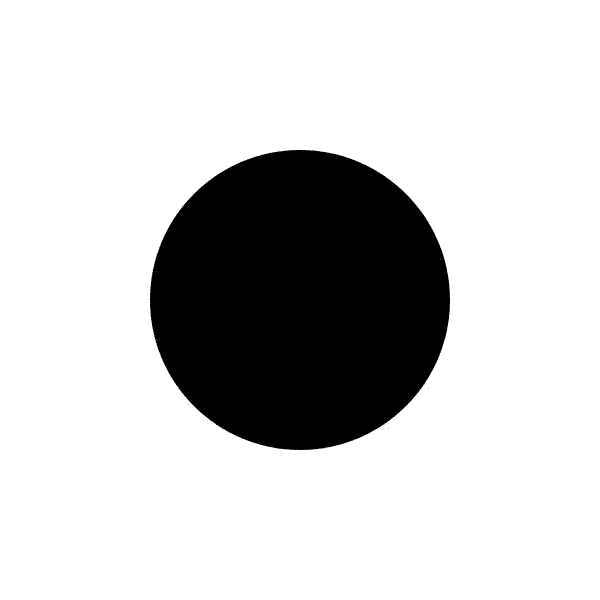
Copyright Akiyoshi Kitaoka 2010 (March 22)
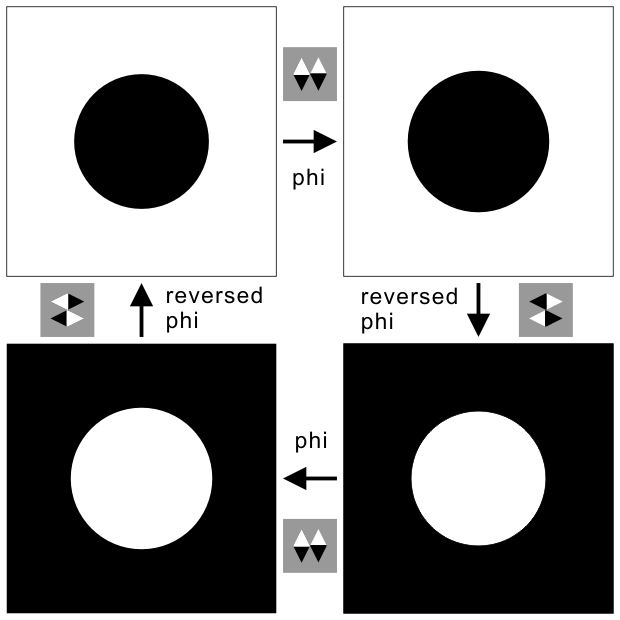
Finding: The direction of motion is the same as the tilt illusion.
cf. van Lier R, Csathó Á, 2005 “Dancing shapes: A comparison of luminance induced distortions” Perception, 35, 775 – 798.
4-stroke motion corresponding to the Mixed Type
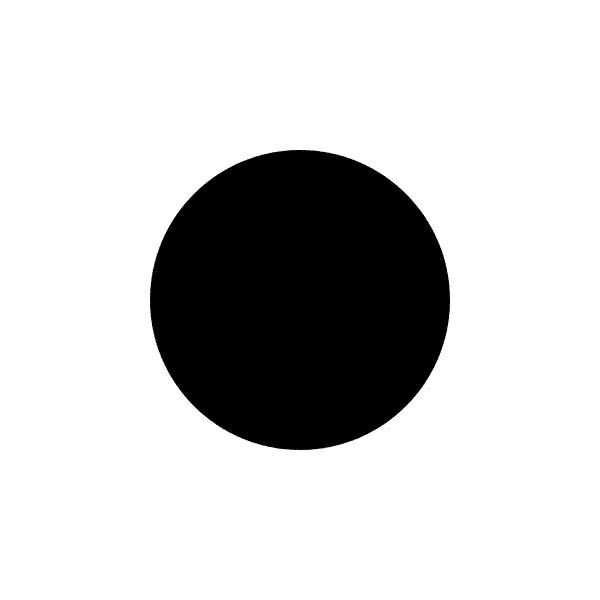
Copyright Akiyoshi Kitaoka 2010 (March 22)
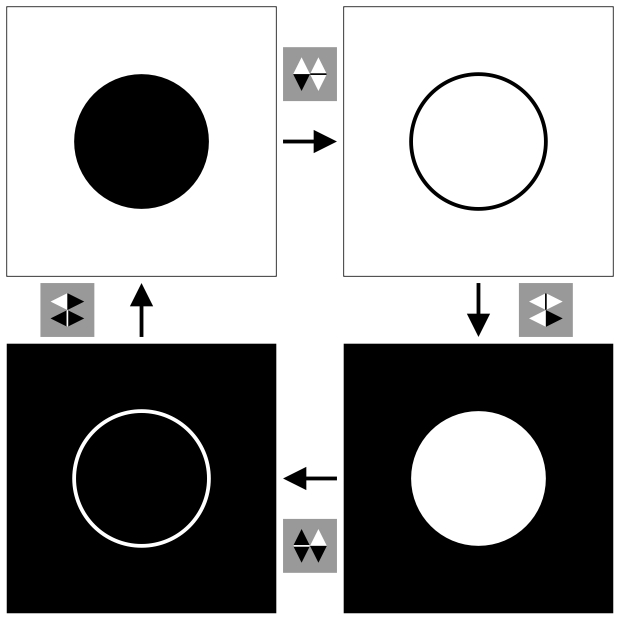
Finding: The direction of motion is the same as the tilt illusion.
<Takeuchi's four-stroke motion>
Takeuchi, T. (1997) The motion analogue of the cafe wall illusion. Perception, 26, 569-584.
Then, anomalous motion illusions that coexist in tilt illusion images can be explained in this context.
When the retinal image slides in the special direction, the orientation along which the tilt illusion occurs, the four-stroke motion is induced and anomalous motion illusion is observed.
Copyright Akiyoshi Kitaoka 2010 (June 26)
<Handout>
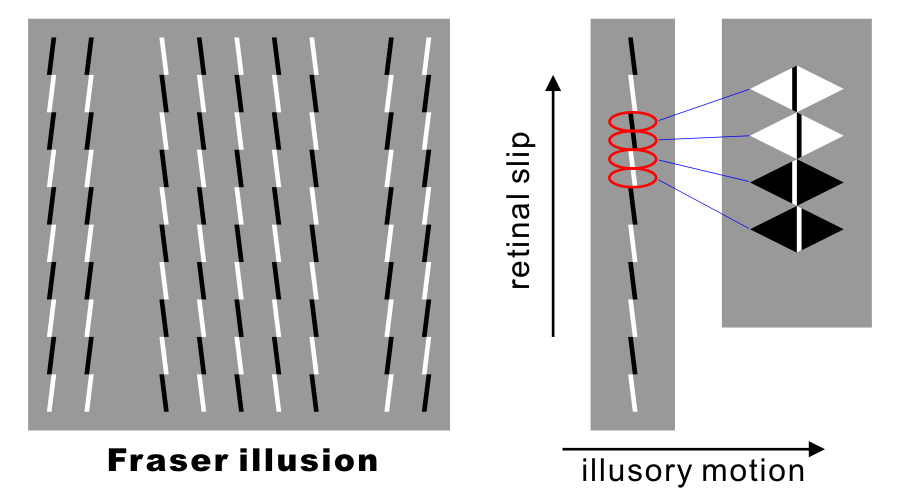
"Rain"
The inset appears to move.
Copyright Aliyoshi Kitaoka 2005 (July 2)
Explanation of the illusion of Y-junctions
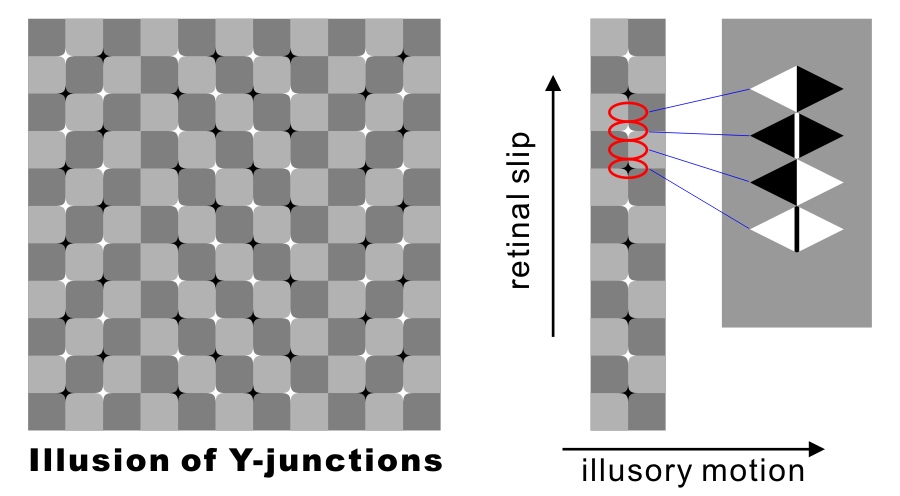
Drawn by Aliyoshi Kitaoka 2010 (June 25)

(Takeuchi's four-stroke motion)
<Two dimensional displays>

Illusion of Y-junctions
Kitaoka, A., Pinna, B., and Brelstaff, G. (2001). New variations of spiral
illusions. Perception, 30, 637-646.
Kitaoka, A., Pinna, B., and Brelstaff, G. (2004). Contrast polarities determine the direction of Cafe Wall tilts. Perception, 33, 11-20.
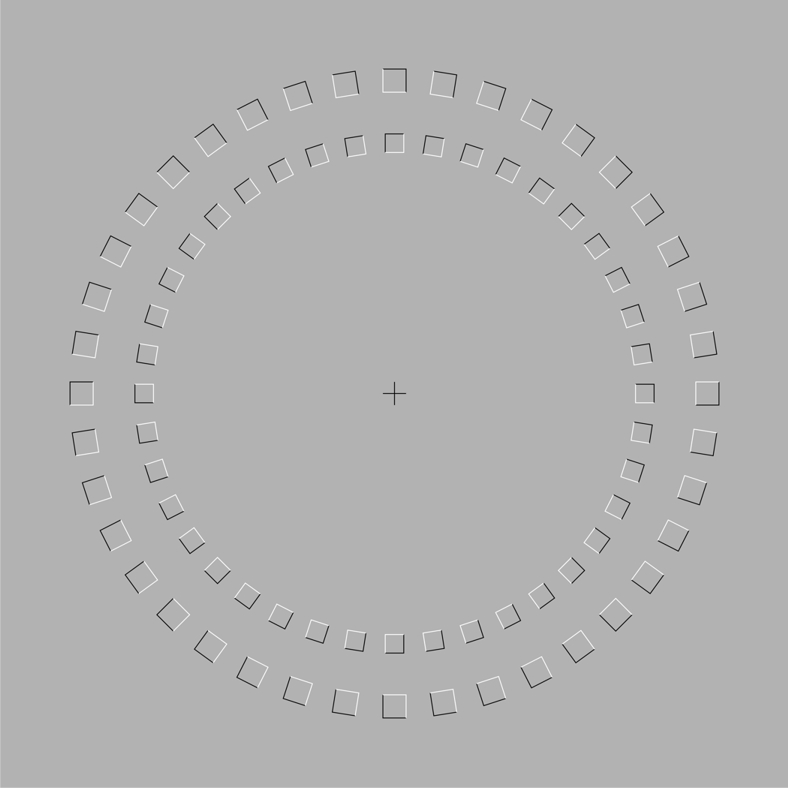
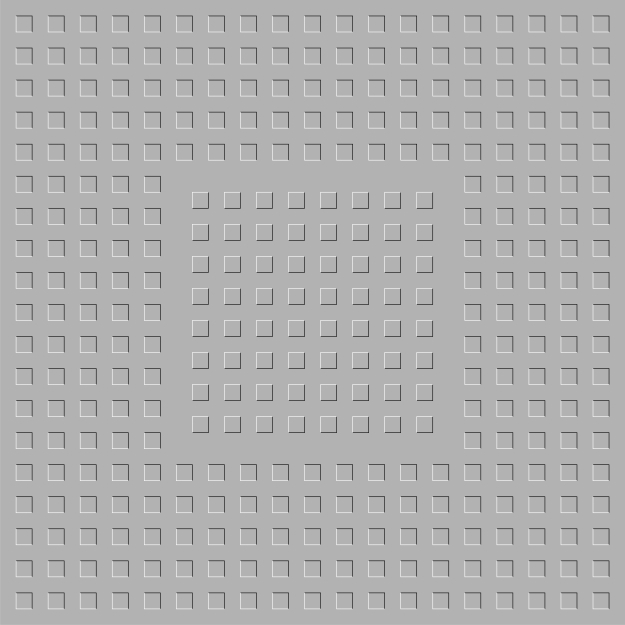
Pinna Illusion
Pinna, B. and Brelstaff, G. J. (2000) A new visual illusion of relative motion. Vision Research, 40, 2091-2096.
Explanation of the Pinna illusion
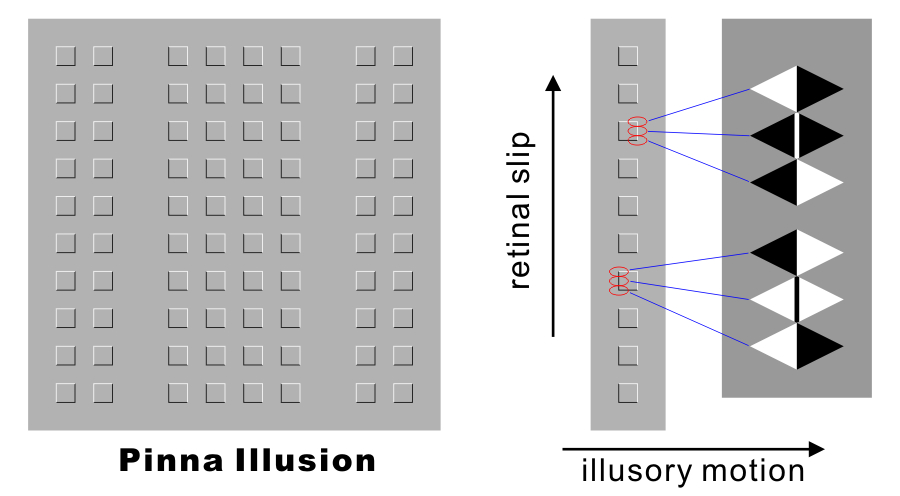
New: This idea led me to produce a novel illusion "spine drift illusion".
"Spine drift
illusion"
The inset appears to move.
Copyright Akiyoshi Kitaoka 2010 (June 4)
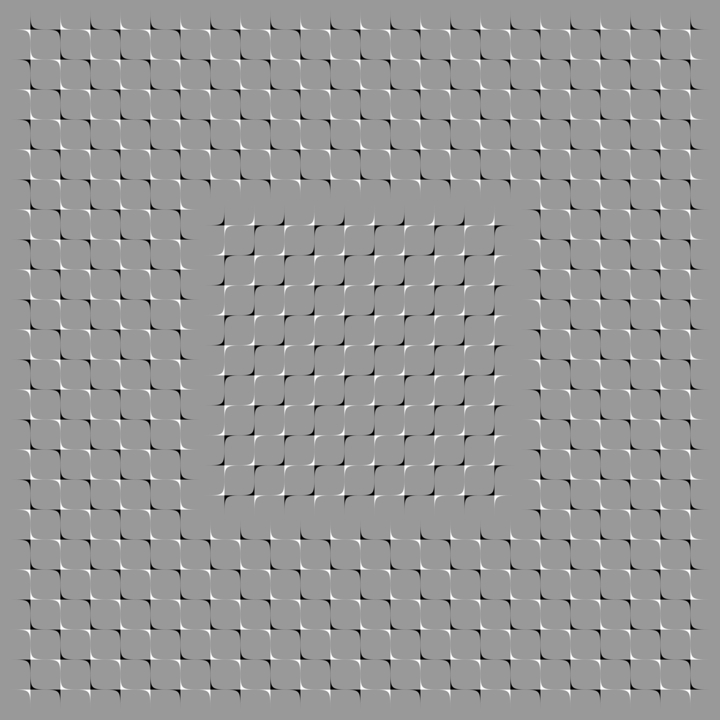
"Spine drift illusion"
The inset appears to move.
Copyright Akiyoshi Kitaoka 2010 (July 6)
<Handout>
"Spine drift
illusion with the illusion of shifted lines"
The inset appears to move.
Copyright Akiyoshi Kitaoka 2010 (June 5)
"Hamburger drift
illusion"
The inset appears to move.
Copyright Akiyoshi Kitaoka 2010 (June 6)
Gabor patches with a special carrier/envelope ratio render anomalous motion illusion.
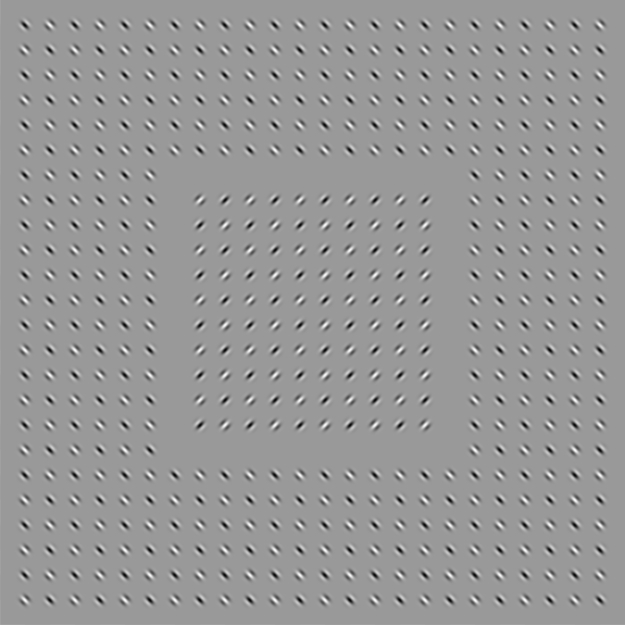
Gabor patch drift illusion (Gurnsey-Morgan illusion)
The inset appears to move.
Drawn by Akiyoshi Kitaoka 2007 (August 8)
<Handout>
cf. Popple illusion (phase-shift illusion)
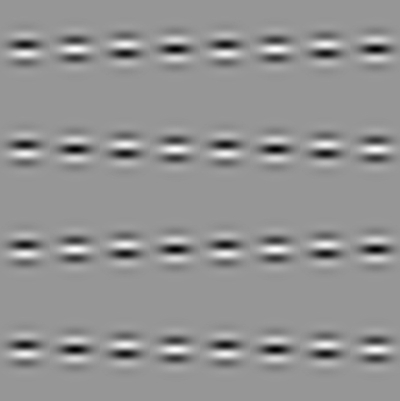
Popple, A. V. and Levi, D. M. (2000) A new illusion demonstrates long-range
processing. Vision Research, 40, 2545-2549.
Popple, A. V. and Sagi, D. (2000) A Fraser illusion without local cues?
Vision Research, 40, 873-878.
§3. A speculation of the "Rotating snakes" illusion
(Optimized Fraser-Wilcox illusion)
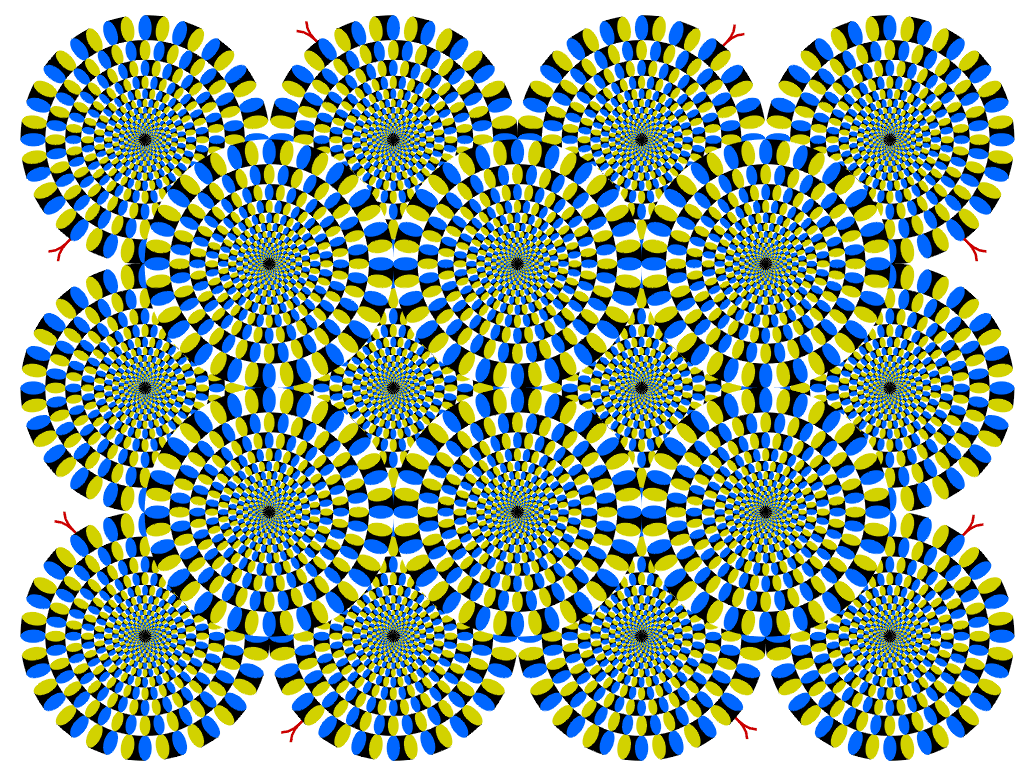
"Rotating snakes"
Circular snakes appear to rotate 'spontaneously'.
Copyright A.Kitaoka 2003 (September 2, 2003)
Explanation of the
elemental illusion (optimized Fraser-Wilcox illusion)
(PDF)
How this
work was created (PDF) (Trick Eyes Graphics
p.78)
The commercial use of this image is not free of charge. Modification of this image for commercial purpose is usually declined. Educational or research use or modification is welcome.
<Handout>
The general rule of motion direction
black → dark-gray → white → light-gray → black
Optimized Fraser-Wilcox illusion, Type I
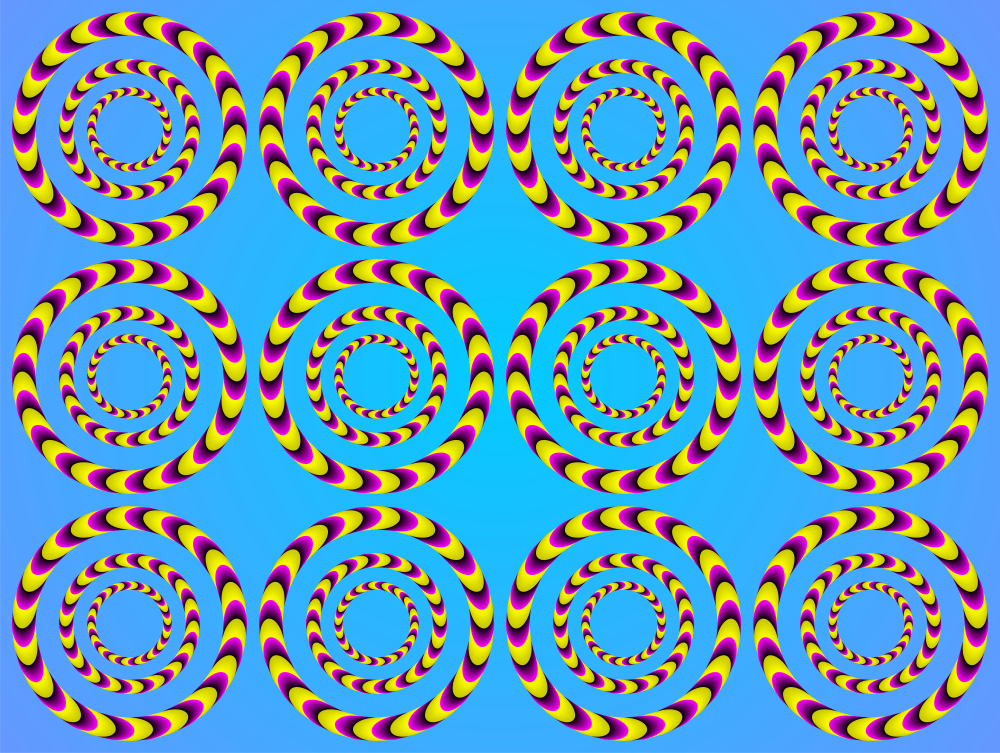
"Pack of rotating red
snakes"
Rings appears to rotate slowly or quickly.
Copyright Akiyoshi Kitaoka 2008 (March 19)
<Handout>
Optimized Fraser-Wilcox illusion, Type IIa
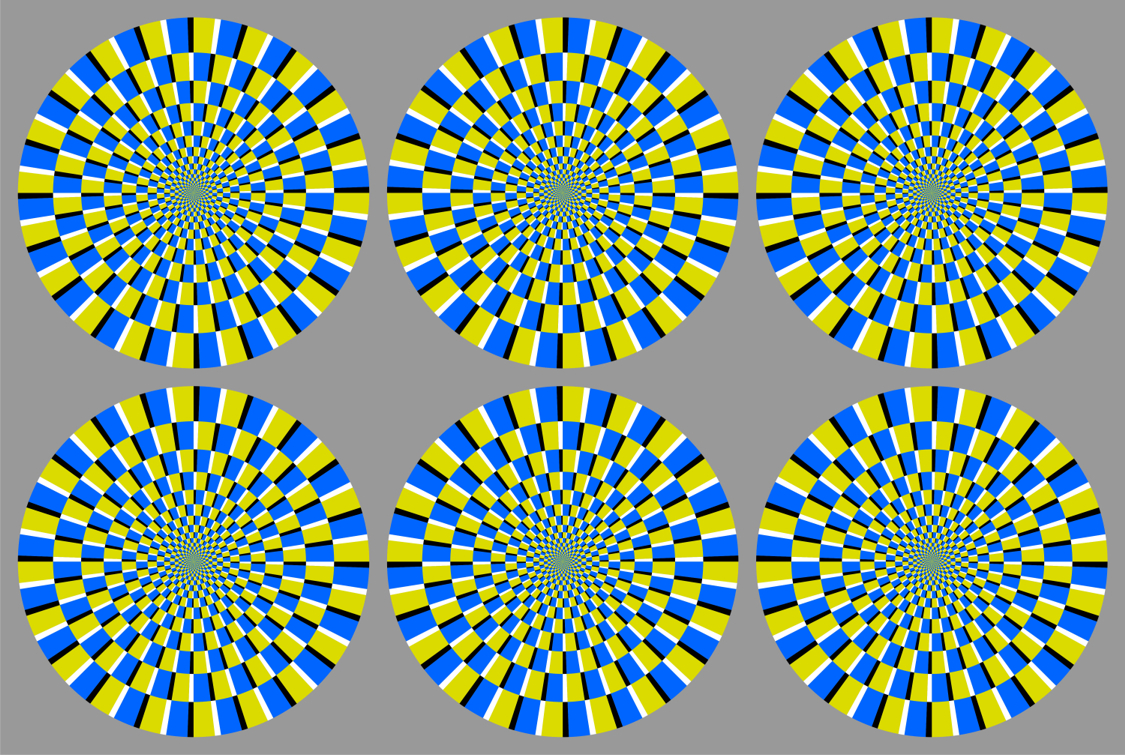
Optimized Fraser-Wilcox illusion, Type III
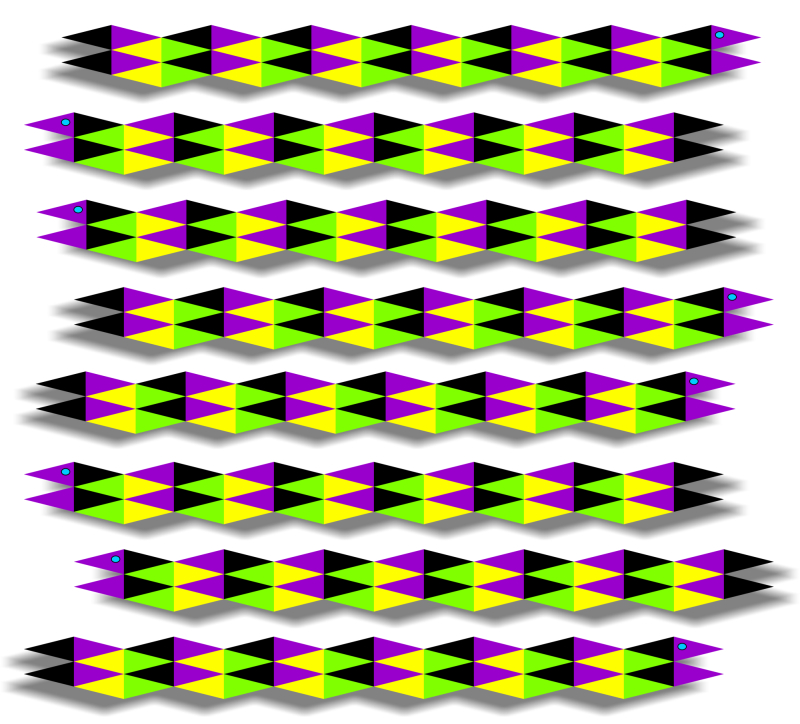
"Moving snakes with
shadows"
Snakes appear to move horizontally.
Copyright Akiyoshi Kitaoka 2009 (June 7)
<Handout>
Optimized Fraser-Wilcox illusion, Type III
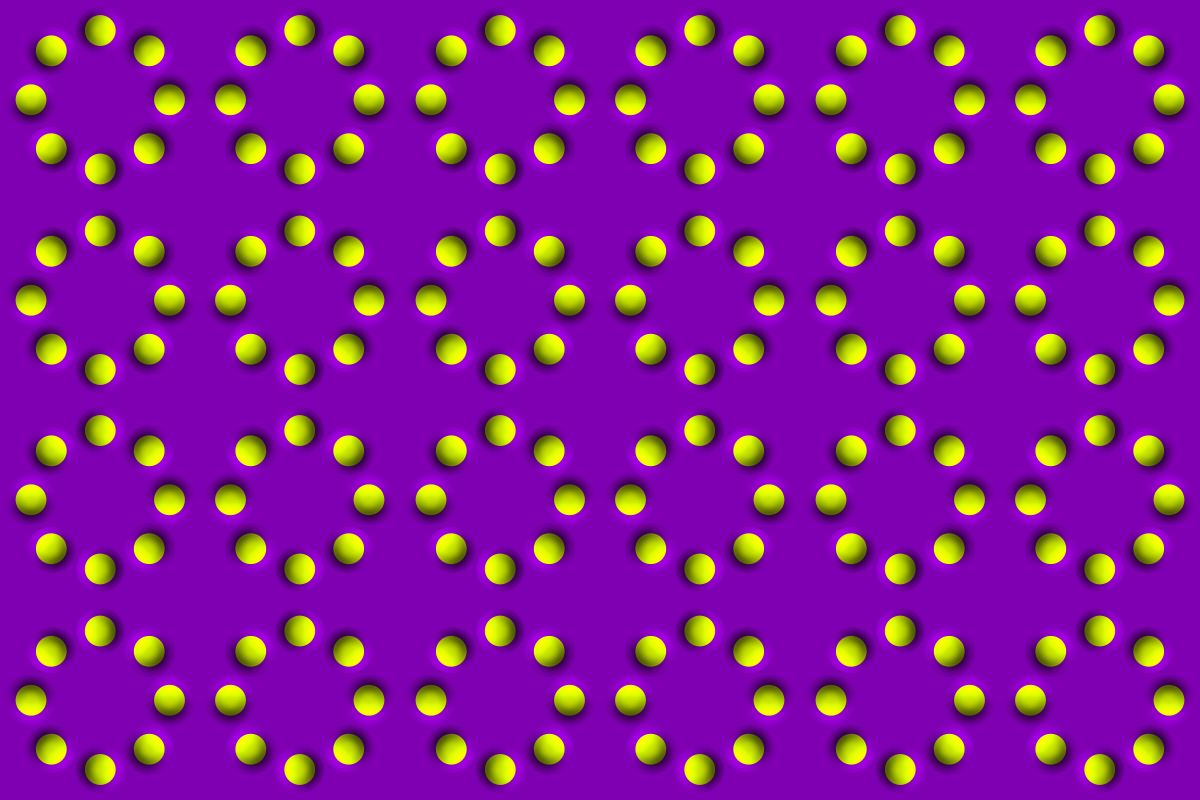
"Rotating
tablets"
(an abundant version)
Rings of tablets appear to rotate.
Copyright Akiyoshi Kitaoka 2009 (March 25)
<Handout>
Optimized Fraser-Wilcox illusion, Type V
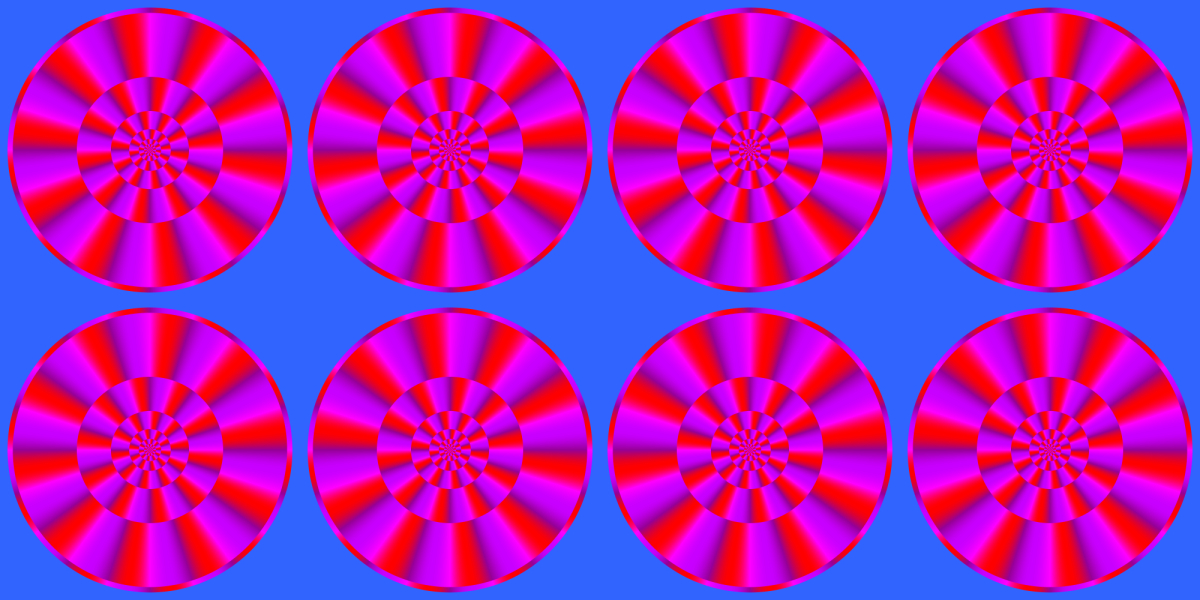
"Rotating red disks"
Disks appear to rotate.
Copyright Akiyoshi Kitaoka 2008 (December 18)
<Handout>
cf. Wezit
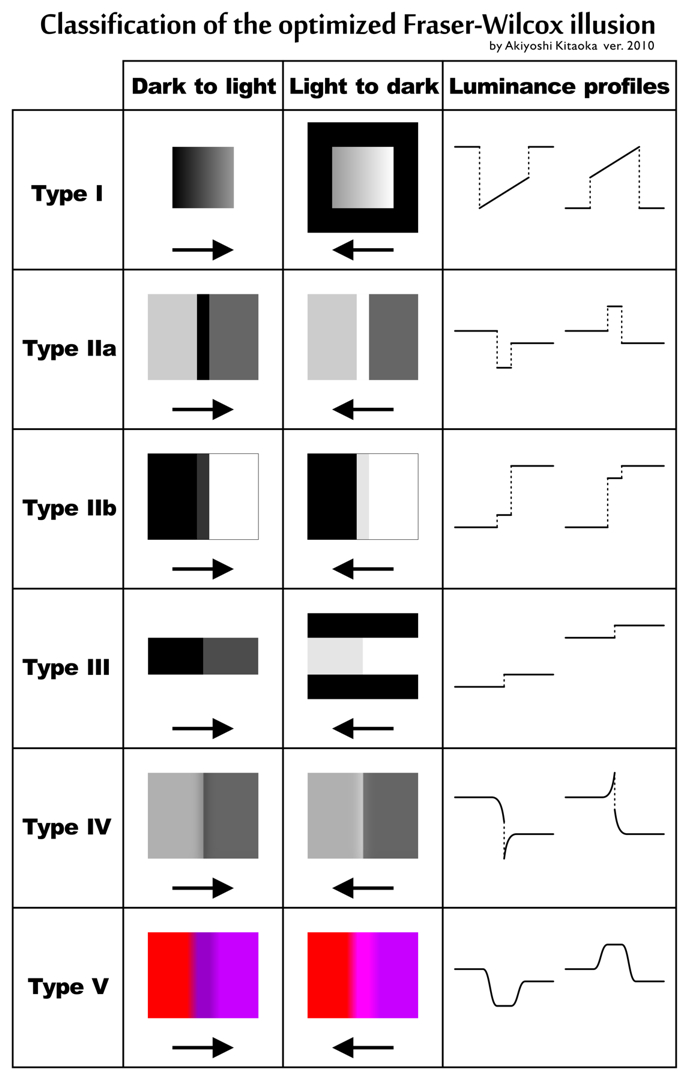
<Handout>
Kitaoka, A. (2007) Phenomenal classification
of the “optimized” Fraser-Wilcox illusion and the effect of color. Poster
presentation in DemoNight, VSS2007, GWiz, Sarasota, Florida, USA, May 14,
2007.
Kitaoka, A. (2008) Optimized Fraser-Wilcox illusions: A pictorial classification by Akiyoshi Kitaoka. Talk in a workshop (WS005) in the 72nd Annual Convention of the Japanese Psychological Association, Hokkaido University, Sapporo, September 19, 2008. Presentation page
For details:
北岡明佳著 人はなぜ錯視にだまされるのか? トリック・アイズ メカニズム カンゼン刊
(定価:1,600円(税別) ISBN 978-4-86255-020-0) amazon.co.jp
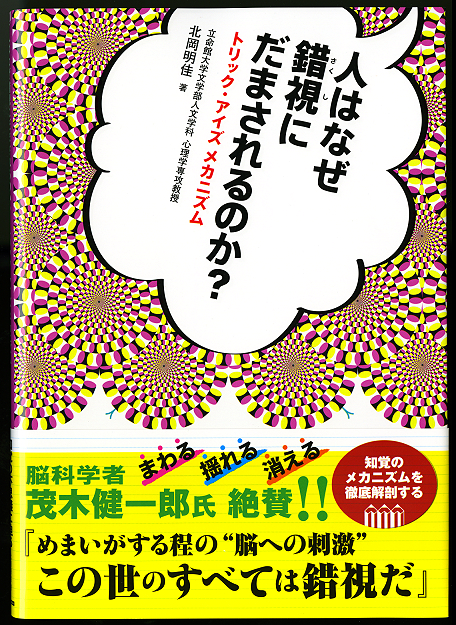
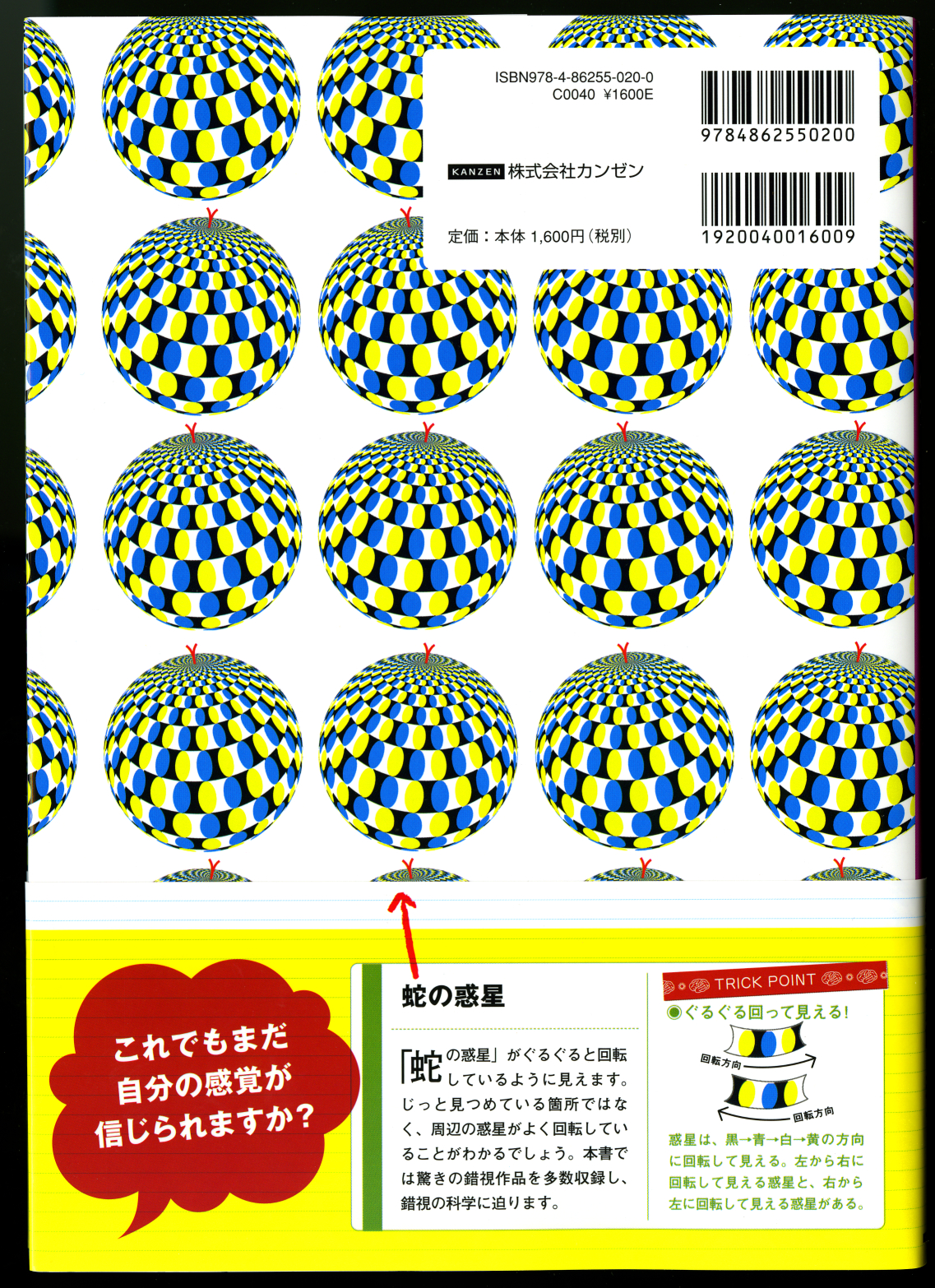
1. Fraser and Wilcox (1979)
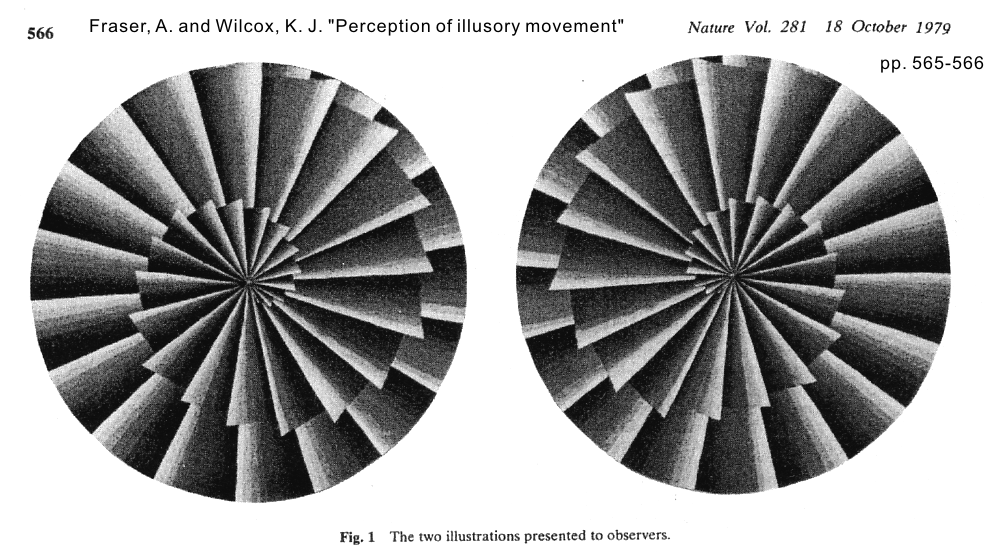
Fraser, A. and Wilcox, K. J. (1979) Perception of illusory movement. Nature, 281, 565-566.
2. Faubert and Herbert (1999)
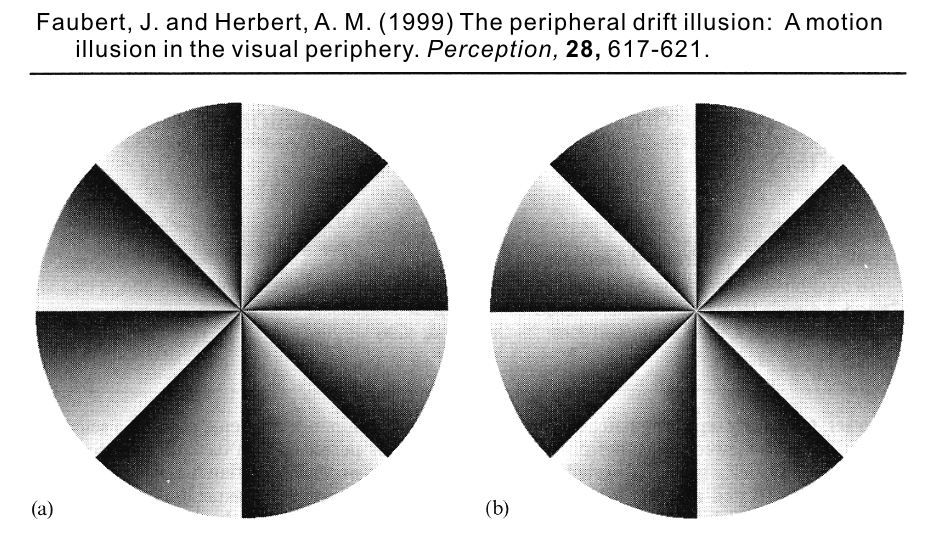
Faubert, J. and Herbert, A. M. (1999) The peripheral drift illusion: A motion illusion in the visual periphery. Perception, 28, 617-621.
3. Naor-Raz and Sekuler (2000)
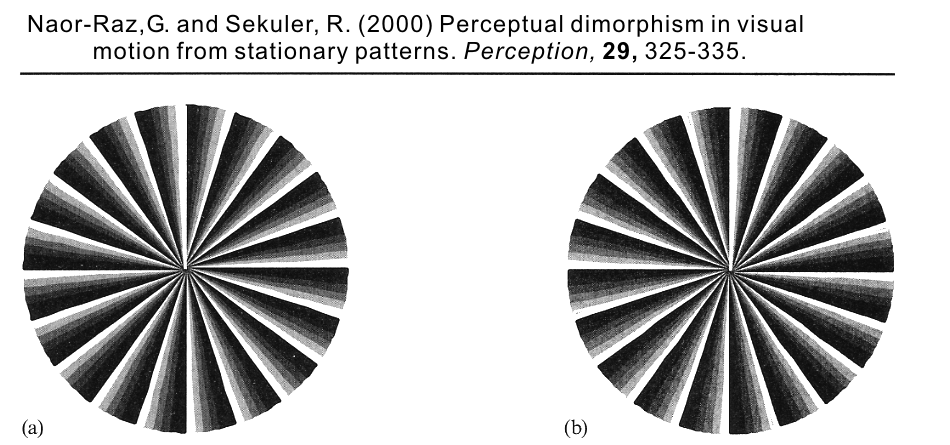
Naor-Raz, G. and Sekuler, R. (2000) Perceptual dimorphism in visual motion from stationary patterns. Perception, 29, 325-335.
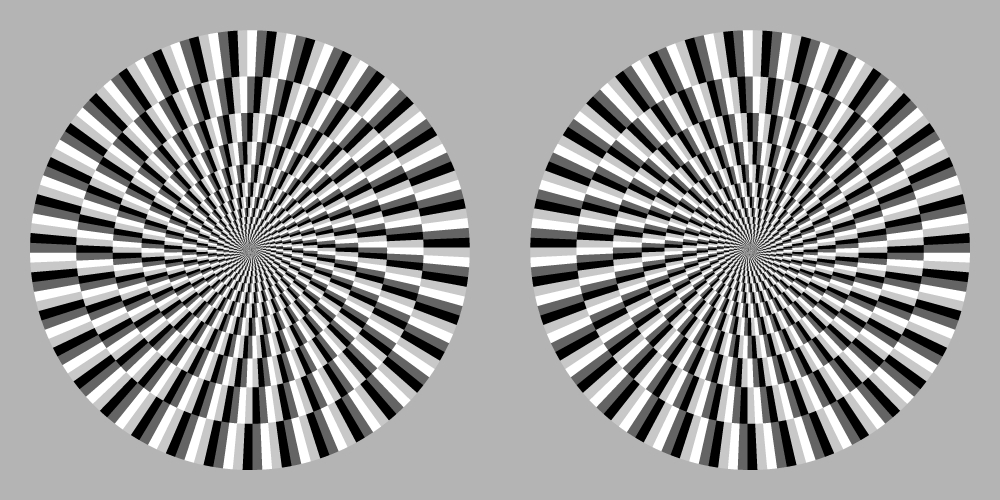
Kitaoka, A. and Ashida, H. (2003) Phenomenal characteristics of the peripheral drift illusion. VISION (Journal of the Vision Society of Japan), 15, 261-262
![]() Related references
Related references ![]()
Tomimatsu, E., Ito, H., Seno, T., and Sunaga, S. (2010) The ‘rotating snakes’ in smooth motion do not appear to rotate. Perception, 39, 721-724.
Fermüller, C., Ji, H., and Kitaoka, A. (2010) Illusory motion due
to causal time filtering. Vision Research, 50,
315–329. ![]()
Kuriki, I., Ashida, H., Murakami, I., and Kitaoka,
A. (2008) Functional brain imaging of the Rotating Snakes illusion by fMRI.
Journal of Vision, 8(10):16, 1-10. ![]()
Hisakata, R. and Murakami, I. (2008) The effects of eccentricity and retinal illuminance on the illusory motion seen in a stationary luminance gradient. Vision Research, 49, 1940-1948.
Beer, A. L., Heckel, A. H. and Greenlee, M. W. (2008) A motion illusion reveals mechanisms of perceptual stabilization. PLoS ONE, 3(7): e2741, 1-7. doi:10.1371/journal.pone.0002741 Freely available online
Chi, M-T., Lee, T-Y., Qu, Y., and Wong, T-T. (2008) Self-Animating Images: Illusory Motion Using Repeated Asymmetric Patterns. ACM Transaction on Graphics (Proceedings of SIGGRAPH 2008), 27, No.3. SIGGRAPH2008 --- Authors' page --- ![]()
Scientific American Reports Special Edition on Perception (2008). ![]()
Kitaoka, A. and Ashida, H. (2007) A variant of the anomalous motion illusion
based upon contrast and visual latency. Perception, 36, 1019-1035. ![]() PDF request to Akiyoshi Kitaoka
PDF request to Akiyoshi Kitaoka ![]()
Newton Press (Ed.), A. Kitaoka (Supervisor)
(2007) Newton magazine book: Special
issue "How is the brain deceived? Perfect demonstration of visual
illusions" Tokyo: Newton Press (in Japanese; published in October 2007). ![]()
Ramachandran, V. S. and Rogers-Ramachandran, D. (2007) A Moving Experience: How the eyes can see movement where it does not exist. Scientific American Mind, February/March, 14-16.
Kitaoka, A. (2007) Phenomenal classification of the “optimized” Fraser-Wilcox
illusion and the effect of color. Poster presentation in DemoNight, VSS2007,
GWiz, Sarasota, Florida, USA, May 14, 2007. 
Murakami, I., Kitaoka, A. and Ashida, H. (2006)
A positive correlation between fixation instability and the strength of illusory
motion in a static display. Vision Research, 46, 2421-2431. ![]() PDF request
should be sent to Dr. Murakami
PDF request
should be sent to Dr. Murakami ![]()
Kitaoka, A. (2006) Anomalous motion illusion and stereopsis. Journal of Three Dimensional Images (Japan), 20, 9-14. PDF (manuscript but the same as the printed one)
Kanazawa, S., Kitaoka, A. and Yamaguchi, M. K. (2006) Infants see the “Rotating Snake” illusion. Dorsal and ventral streams in the visual system (Talk): Monday, 21 August 2006; 12:00-12:30 (29th European Conference on Visual Perception, St-Petersburg, Russia, 20th-25th August, 2006) Abstract
Kitaoka, A., Ashida, H., and Murakami, I. (2005) Does the peripheral drift illusion generate illusory motion in depth? Journal of Three Dimensional Images (Tokyo), 19, 6-8. PDF (scanned copy) (poor quality) --- MS-Word file (manuscript, the same as the paper) (high quality)
Conway, R. B., Kitaoka, A., Yazdanbakhsh, A., Pack, C. C., and Livingstone,
M. S. (2005) Neural basis for a powerful static motion illusion. Journal of Neuroscience, 25, 5651-5656. ![]() PDF request should be sent to Dr. Conway
PDF request should be sent to Dr. Conway ![]()
Backus, B. T. and Oruç, I. (2005) Illusory motion from change over time in the response to contrast and luminance. Journal of Vision, 5, 1055-1069. http://journalofvision.org/5/11/10/
Kitaoka, A. and Ashida, H. (2003) Phenomenal characteristics of the peripheral drift illusion. VISION, 15, 261-262.PDF
Findings of the "Rotating snakes" illusion (optimized Fraser-Wilcox illusion)
1. Illusion is strong in the peripheral vision
Kitaoka, A. and Ashida, H. (2003) Phenomenal characteristics of the peripheral drift illusion. VISION, 15, 261-262.PDF
2. Illusion is strong when the image is of high luminance
Hisakata, R. and Murakami, I. (2008) The effects of eccentricity and retinal illuminance on the illusory motion seen in a stationary luminance gradient. Vision Research, 49, 1940-1948.
3. Illusion requires some eye movement
Murakami, I., Kitaoka, A. and Ashida, H. (2006) A positive correlation between fixation instability and the strength of illusory motion in a static display. Vision Research, 46, 2421-2431.
Kuriki, I., Ashida, H., Murakami, I., and Kitaoka, A. (2008) Functional brain imaging of the Rotating Snakes illusion by fMRI. Journal of Vision, 8(10):16, 1-10.
4. Illusion does not occur in the stabilized retinal image
Murakami, I., Kitaoka, A. and Ashida, H. (2006) A positive correlation between fixation instability and the strength of illusory motion in a static display. Vision Research, 46, 2421-2431.
5. Illusion is enhanced by color
Kitaoka, A. (2007) Phenomenal classification of the “optimized” Fraser-Wilcox illusion and the effect of color. Poster presentation in DemoNight, VSS2007, GWiz, Sarasota, Florida, USA, May 14, 2007.
6. Illusion is weak when the image is moved
Tomimatsu, E., Ito, H., Seno, T., and Sunaga, S. (2010) The ‘rotating snakes’ in smooth motion do not appear to rotate. Perception, 39, 721-724.
7. Illusion is weak when the image is observed through pinholes
Cantor, C. R. L., Tahir, H. J., and Shor, C. M. (2010) Is the rotating snakes an optical illusion? VSS2010, #26.434.
Major models of the "Rotating snakes" illusion (optimized Fraser-Wilcox illusion)
1. Adaptation (temporal positional shift)
Backus, B. T. and Oruç, I. (2005) Illusory motion from change over time in the response to contrast and luminance. Journal of Vision, 5, 1055-1069.
2. Visual delay (temporal positional shift) related issue 1 _ related issue 2
Conway, R. B., Kitaoka, A., Yazdanbakhsh, A., Pack, C. C., and Livingstone, M. S. (2005) Neural basis for a powerful static motion illusion. Journal of Neuroscience, 25, 5651-5656.
3. Motion signal asymmetry
Murakami, I., Kitaoka, A. and Ashida, H. (2006) A positive correlation between fixation instability and the strength of illusory motion in a static display. Vision Research, 46, 2421-2431.
4. Imaginary motion detector model (My speculation)
1. Imaginary motion detectors for the optimized Fraser-Wilcox illusion Type IIa
(the same configuration as the line components in the Fraser illusion family)
2. It is assumed that the image given to imaginary motion detectors gradually becomes clear after presentation or refreshment.
3. This temporal change activates the imaginary motion detector in the same manner as the (classic) reversed phi (Anstis, 1970) or phenomenal phenomena (Gregory and Heard, 1983).
Flash(swf) --- QuickTime(mov)
Kitaoka, A. (2006) Configurational coincidence among six phenomena: A comment on van Lier and Csathó (2006). Perception, 35, 799-806. animations
By the way, I explain the perceptual dimorphism in motion direction, assuming
that two independent illusions are involved in the original Fraser-Wilcox
illusion.
| Type | Basic illusion that motion direction is from dark to light |
Basic illusion that motion direction is from light to dark |
Examples (click the thumbnail) |
| I | 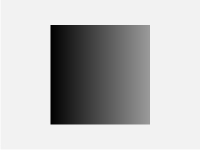 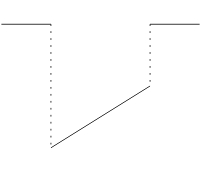 |
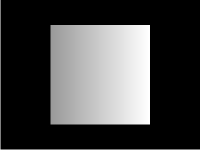 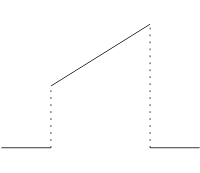 |
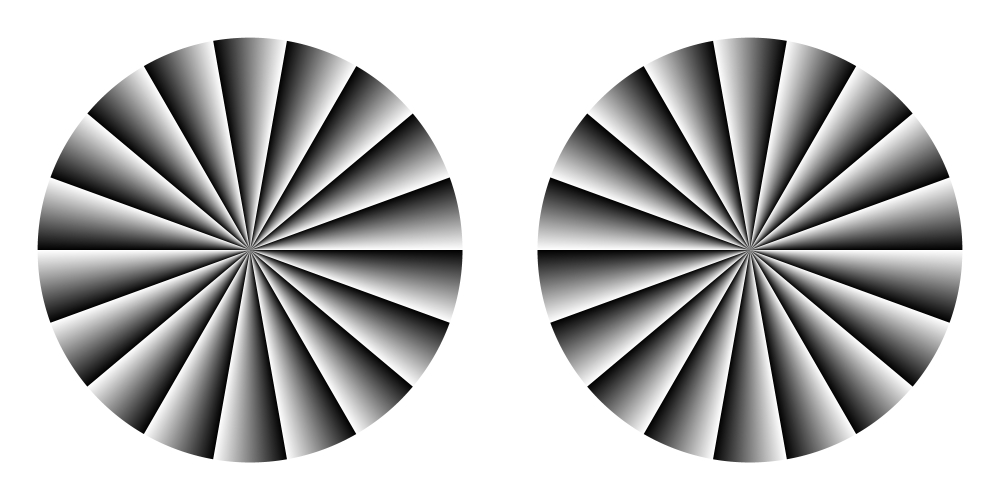
"Dark to light" (in gradation) might be stronger.
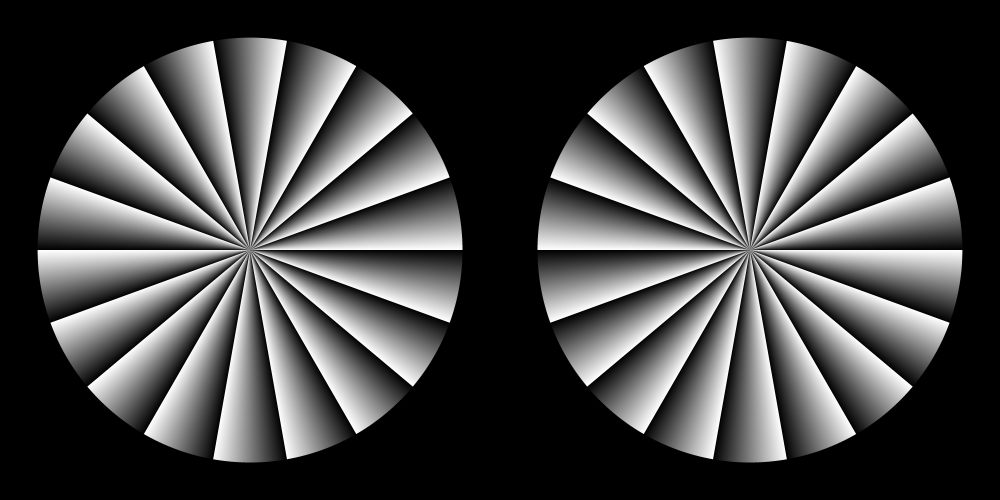
"Light to dark" might be stronger.
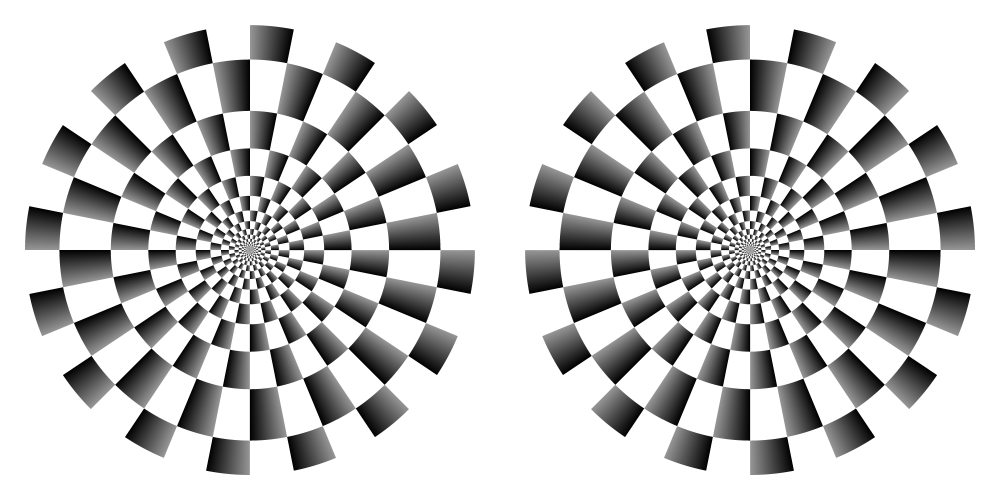
"Dark to light"
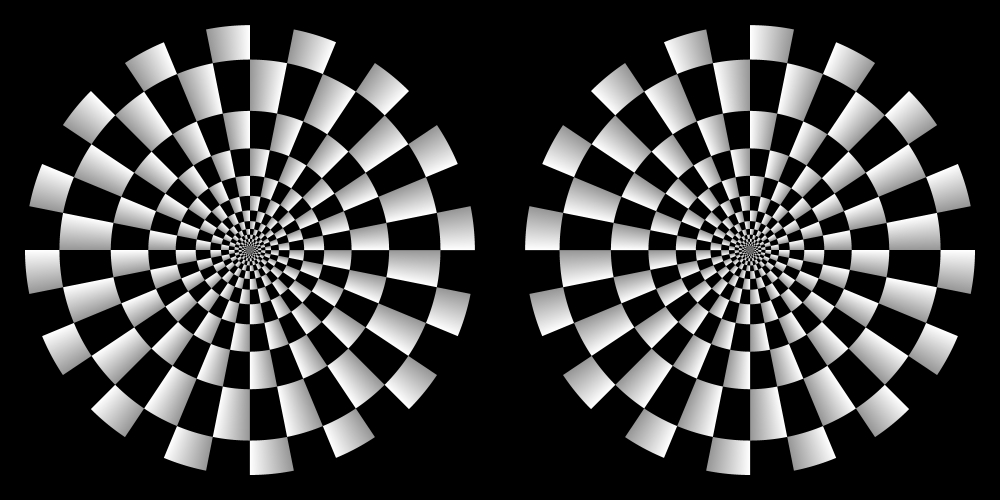
"Light to dark"
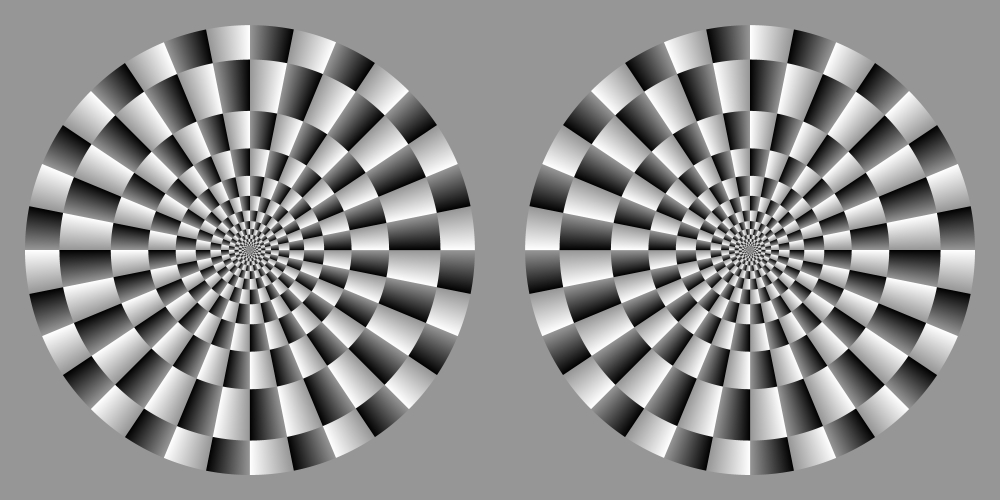
"Dark to light" and "light to dark" in cooperation
I propose an empirical observation that color might enhance the illusion in some conditions.
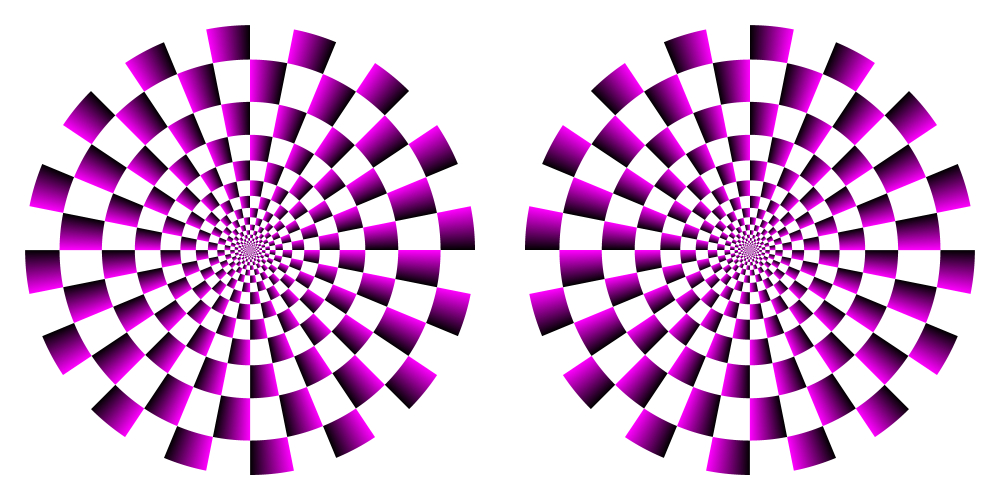
Observation 1. The illusion from dark to light is enhanced by red or blue.
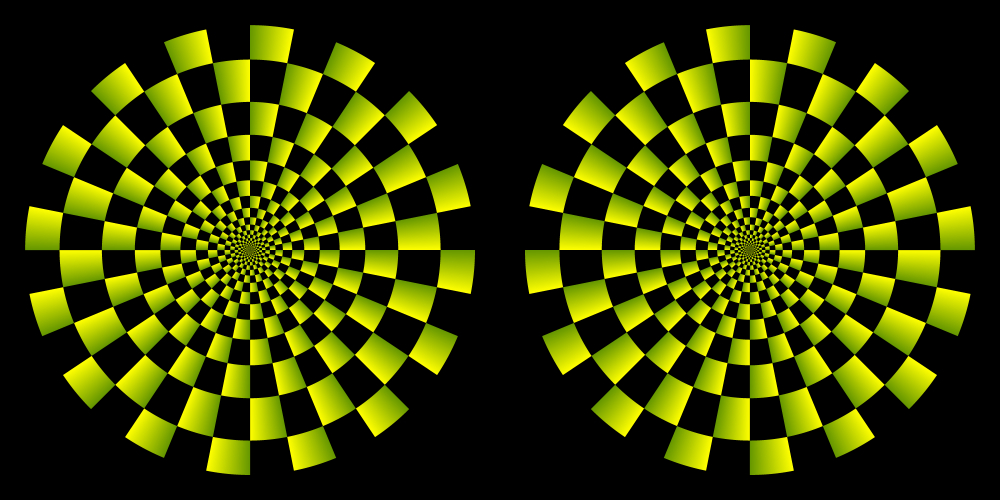
Observation 2. The illusion from light to dark is enhanced by yellow or green.
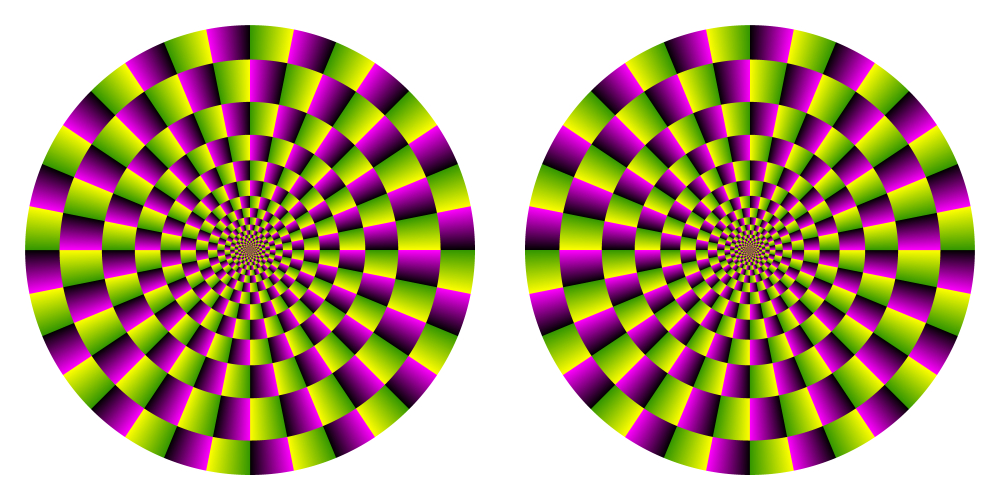
Observation 3. The illusion from dark to light is enhanced by red or blue, while the illusion from light to dark is enhanced by yellow or green. Both illusions work additively.
Motion illusion by visual delay
"Fluttering-heart like fluttering hearts"
The four hearts appear to move in the same direction as the retinal slip.
Copyright Akiyoshi Kitaoka 2006 (December 20)
<Handout>
cf. fluttering-heart illusion

(Helmholtz, 1867; Nguyen-Tri and Faubert 2003; von Grünau 1975a,
1975b, 1976; von Kries 1896)
Color is not indispensable.
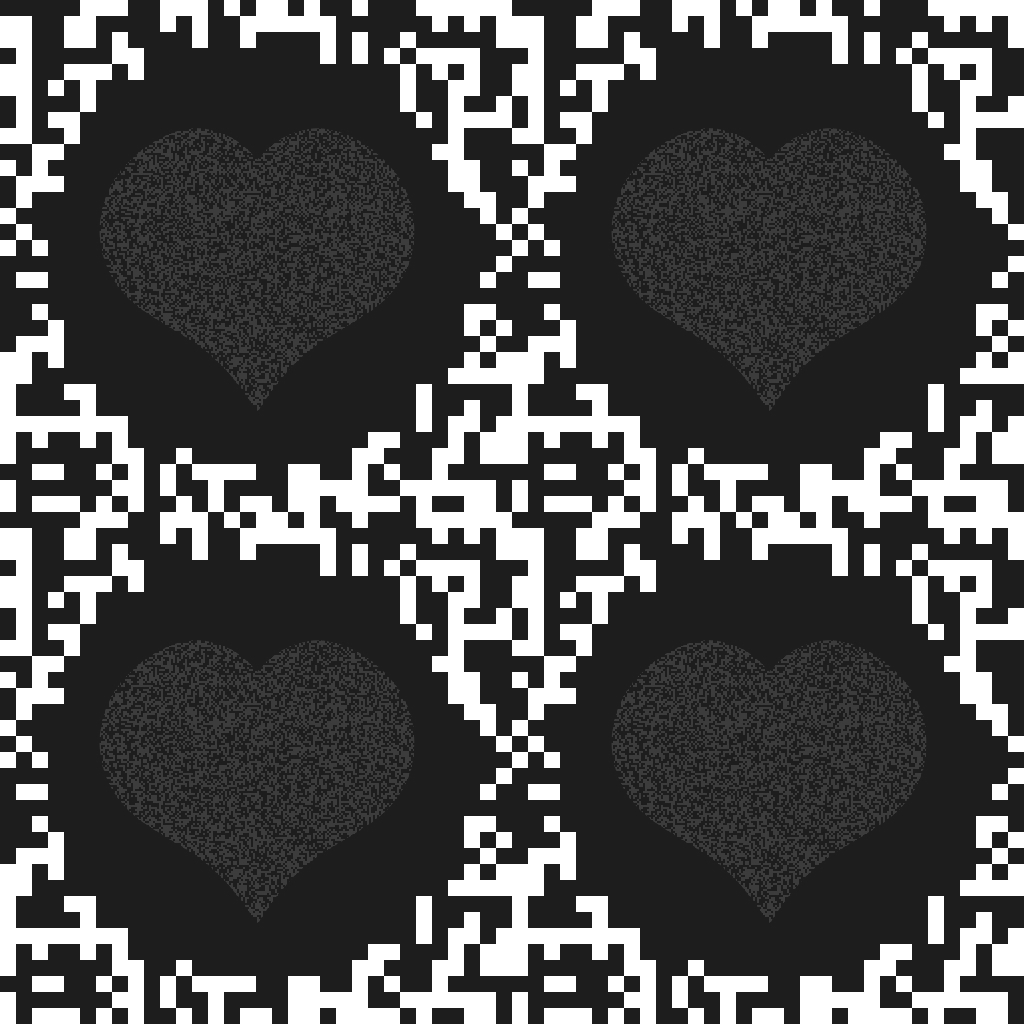
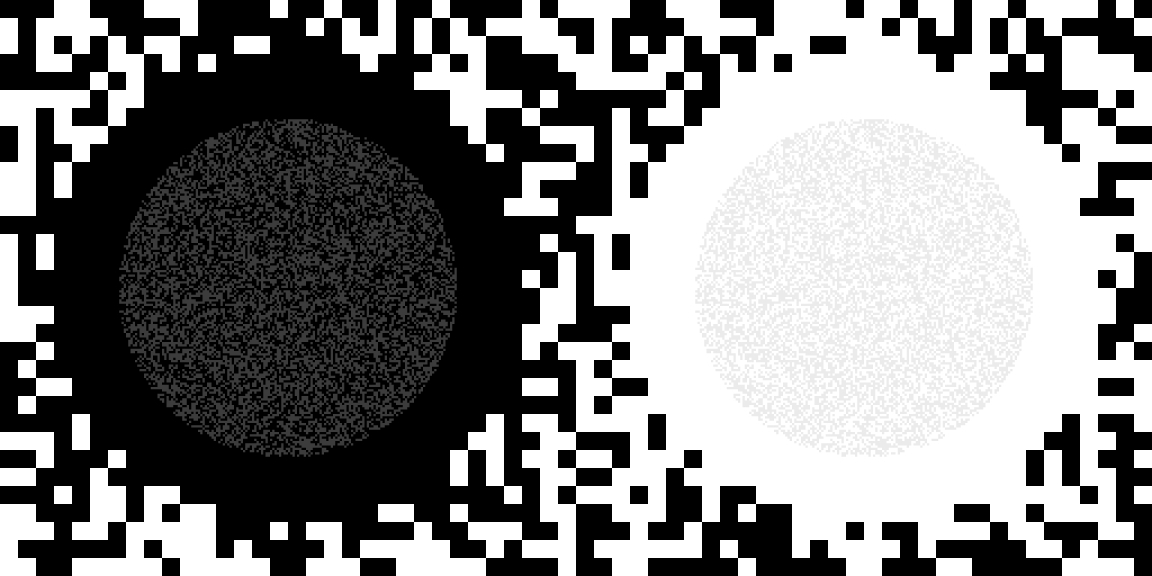
Finding:
1. Low-luminance parts give longer latency than high-luminance parts.
2. Low-contrast parts give longer latency than high-contrast parts. <our finding!>
Kitaoka, A. and Ashida, H. (2007) A variant of the anomalous motion illusion based upon contrast and visual latency. Perception, 36, 1019-1035.
The "central drift illusion" is featured by illusory motion in the direction low-to-high contrast.
Kitaoka, A. and Ashida, H. (2004) A new
anomalous motion illusion: the "central drift illusion". The 2004's winter meeting of the Vision Society
of Japan at the Kogakuin University, Shinjuku, Tokyo, Japan, 2004/1/26-28,
1/26 oral publication. Presentation (html)
This illusion does not depend on the luminance gradient of inducers. Although the luminance gradients are the same (white to gray) between the two figures shown below, the direction of illusory motion is opposite to each other. The upper two rows in the left figure appear to move leftward while those in the right figure appear to slide rightward; the lower two rows in the left figure appear to move rightward while those in the right figure appear to slide leftward.

The only difference in stimuli is whether the background is gray or white. It is therefore suggested that the critical factor to generate this illusion be contrast. In this case, the direction of illusory motion can be described as "low-to-high contrast".
The difference in color does not disturb this illusion as long as the luminance order is maintained. In the figure shown below, the first, fourth, fifth and eighth rows appear to move leftward while the rest appear to slide rightward.
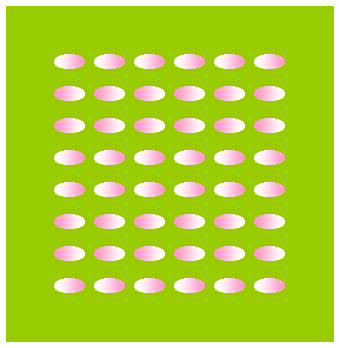
The green and the pink should be of the same luminance or the former should be darker than the latter. This demonsrtation was not good in the VSJ meeting because the green of the projecter was much brighter than the pink.
A demonstration of the illusory motion made up of an ensemble of the two subtypes. The upper and lower rows appear to move leftward, while the middle one appears to slide rightward.
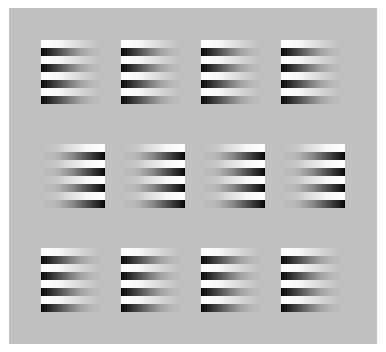
News: My new book "Introduction to visual illusions" will soon be published!
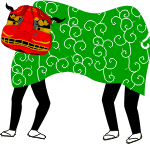 おしまい (The end)
おしまい (The end)
Thank you!
ご清聴ありがとうございました。

